Ads
भारत में बाबर के आगमन का महत्व इस प्रकार है -
भू-रणनीतिक महत्व
काबुल और कंधार ने हमेशा भारत में आक्रमण के लिए मंचन स्थल के रूप में काम किया था, बाबर के आगमन ने काबुल और कंधार को उत्तर भारत के एक साम्राज्य के अभिन्न अंग बना दिया।
बाबर और उसके उत्तराधिकारियों ने पिछले 200 वर्षों से लगातार जारी बाहरी आक्रमण से भारत की सुरक्षा को मजबूत किया।
आर्थिक महत्व
भौगोलिक दृष्टि से काबुल और कंधार व्यापार मार्ग में स्थित हैं; इसलिए, इन दो क्षेत्रों के नियंत्रण ने भारत के विदेशी व्यापार को मजबूत किया।
बाबर ने ताज की प्रतिष्ठा को फिर से स्थापित करने का प्रयास किया, जो फिरोज तुगलक की मृत्यु के बाद नष्ट हो गया था।
ज़हीर अल-दीन मुहम्मद (बाबर)
बाबर का जन्म 14 फरवरी 1483 को मुगलिस्तान (वर्तमान उज्बेकिस्तान) के अंदीजान में हुआ था।
बाबर को एशिया के दो सबसे महान योद्धाओं अर्थात् चांगेज़ और तैमूर के वंशज होने की प्रतिष्ठा प्राप्त थी।
बाबर ने अपने व्यक्तिगत गुणों से खुद को भीख के लिए तैयार किया। वह अपने सैनिकों के साथ कठिनाइयों को साझा करने के लिए हमेशा तैयार रहता था।
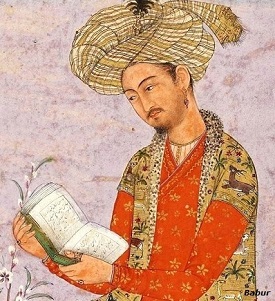
बाबर शराब और अच्छी संगत का शौकीन था और एक अच्छा और हंसमुख साथी था। साथ ही, वे एक सख्त अनुशासक और एक कठोर कार्य करने वाले थे।
बाबर ने अपनी सेना और अन्य कर्मचारियों की अच्छी देखभाल की, और जब तक वे विश्वासघाती नहीं थे, तब तक वे अपने कई दोषों को क्षमा करने के लिए तैयार थे।
हालांकि बाबर एक रूढ़िवादी सुन्नी था, लेकिन वह धार्मिक देवताओं के पूर्वाग्रह या नेतृत्व में नहीं था। एक बार, ईरान और तूरान में शियाओं और सुन्नियों के बीच एक कटु सांप्रदायिक संघर्ष था; हालाँकि, ऐसी स्थिति में, बाबर का दरबार धार्मिक और सांप्रदायिक संघर्षों से मुक्त था।
हालांकि बाबर ने राणा सांगा के खिलाफ लड़ाई को जिहाद घोषित कर दिया और जीत के बाद ' गाजी ' की उपाधि धारण की , लेकिन इसके कारण स्पष्ट रूप से राजनीतिक थे।
बाबर फ़ारसी और अरबी भाषाओं का स्वामी था, और उसे तुर्की भाषा (जो उसकी मातृभाषा थी) में सबसे प्रसिद्ध लेखकों में से एक माना जाता है।
बाबर के प्रसिद्ध संस्मरण, तुजुक-ए-बाबरी को विश्व साहित्य के क्लासिक्स में से एक माना जाता है। उनकी अन्य लोकप्रिय रचनाएँ मसनवी और एक प्रसिद्ध सूफी कृति का तुर्की अनुवाद हैं।
बाबर एक उत्सुक प्रकृतिवादी थे, क्योंकि उन्होंने भारत के वनस्पतियों और जीवों का काफी विस्तार से वर्णन किया था।
बाबर ने राज्य की एक नई अवधारणा पेश की, जो − . पर आधारित थी
ताज की ताकत और प्रतिष्ठा;
धार्मिक और सांप्रदायिक कट्टरता का अभाव; तथा
संस्कृति और ललित कलाओं को सावधानीपूर्वक बढ़ावा देना।
बाबर ने इन तीनों विशेषताओं (ऊपर चर्चा की गई) के साथ, अपने उत्तराधिकारियों के लिए एक मिसाल और एक दिशा प्रदान की।
The significance of Babur’s advent into India are as follows −
Geo-strategic Significance
Kabul and Qandhar had always acted as staging places for an invasion in India, Babur’s advent made Kabul and Qandhar the integral parts of an empire comprising north India.
Babur and his successors strengthen the India security from an external invasion, which were persistent from the last 200 years.
Economic Significance
Geographically Kabul and Qandhar positioned in the trade route; therefore, the control of these two regions strengthened India's foreign trade.
Babar attempted to re-establish the prestige of the Crown, which had been eroded after the death of Firuz Tughlaq.
Zahir al-Din Muhammad (Babur)
Babur born on 14 February 1483 at Andijan in Mughalistan (present day Uzbekistan).
Babur had the prestige of being a descendant of two of the most legendary warriors of Asia namely Changez, and Timur.
Babur groomed himself to his begs by his personal qualities. He was always prepared to share the hardships with his soldiers.

Babur was fond of wine and good company and was a good and cheerful companion. At the same time, he was a strict disciplinarian and a hard taskmaster.
Babur took good care of his army and other employees, and was prepared to excuse many of their faults as long as they were not disloyal.
Though Babur was an orthodox Sunni, but he was not prejudiced or led by the religious divines. Once, there was a bitter sectarian conflict between the Shias and the Sunnis in Iran and Turan; however, in such a condition, Babur’s court was free from theological and sectarian conflicts.
Though Babur declared the battle against Rana Sanga a jihad and assumed the title of ‘ghazi’ after the victory, but the reasons were noticeably political.
Babur was master of Persian and Arabic languages, and is regarded as one of the most famous writers in the Turkish language (which was his mother tongue).
Babur’s famous memoirs, the Tuzuk-i-Baburi is considered as one of the classics of world literature. His other popular works are masnavi and the Turkish translation of a well-known Sufi work.
Babur was a keen naturalist, as he described the flora and fauna of India in considerable details.
Babur introduced a new concept of the state, which was to be based on −
The strength and prestige of the Crown;
The absence of religious and sectarian bigotry; and
The careful fostering of culture and the fine arts.
Babur, with all these three features (discussed above), provided a precedent and a direction for his successors.
बाबर की विजय का महत्व || significance of Babur’s conquest
मुगल सम्राट बाबुरी द्वारा लड़े गए प्रमुख युद्ध निम्नलिखित हैं
पानीपत की पहली लड़ाई
20 अप्रैल 1526 को, पानीपत की पहली लड़ाई, बाबर और इब्राहिम लोदी साम्राज्य (दिल्ली के शासक) के बीच लड़ी गई थी । युद्ध उत्तर भारत (पानीपत) में हुआ और मुगल साम्राज्य की शुरुआत के रूप में चिह्नित किया गया।
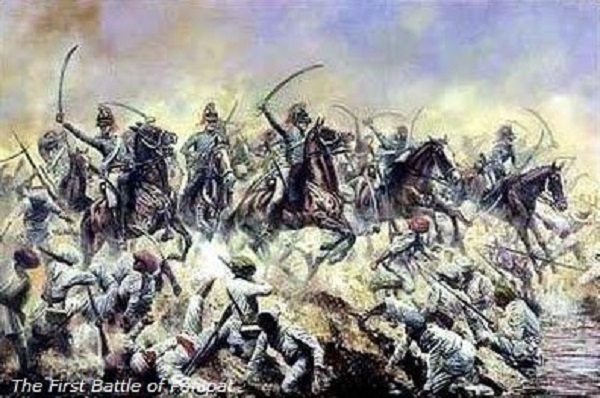
पानीपत की पहली लड़ाई उन शुरुआती लड़ाइयों में से एक थी जिसमें बारूद की आग्नेयास्त्रों और फील्ड आर्टिलरी का इस्तेमाल किया गया था। हालांकि, बाबर ने कहा कि उसने पहली बार भीरा किले पर अपने हमले में इसका इस्तेमाल किया था।
इब्राहिम लोदी ने पानीपत में बाबर से मुलाकात की, जिसमें अनुमानित बल 100,000 पुरुषों और 1,000 हाथियों के साथ था।
बाबर ने केवल 12,000 की ताकत के साथ सिंधु को पार किया था; हालाँकि, भारत में, बड़ी संख्या में हिंदुस्तानी रईस और सैनिक पंजाब में बाबर में शामिल हो गए। भारतीय सेना के समर्थन के बावजूद, बाबर की सेना संख्यात्मक रूप से हीन थी।
बाबर ने एक मास्टर प्लान बनाया और अपनी स्थिति मजबूत की। उसने अपनी सेना के एक विंग को पानीपत शहर में आराम करने का आदेश दिया, जिसमें बड़ी संख्या में घर थे। इसके अलावा, उसने पेड़ों की शाखाओं से भरी खाई के माध्यम से दूसरे पंख की रक्षा की।
सामने की तरफ, बाबर ने बचाव की दीवार के रूप में कार्य करने के लिए बड़ी संख्या में डिब्बे से वार किया। दो गाडि़यों के बीच ब्रेस्टवर्क खड़े किए गए ताकि सैनिक अपनी बंदूकें आराम कर सकें और गोलियां चला सकें।
बाबर ने ओटोमन (रूमी) उपकरण तकनीक का इस्तेमाल किया, जिसका इस्तेमाल ओटोमन्स ने ईरान के शाह इस्माइल के खिलाफ अपनी प्रसिद्ध लड़ाई में किया था।
बाबर ने उस्ताद अली और मुस्तफा नामक दो तुर्क मास्टर-गनरों को भी आमंत्रित किया था ।
हालाँकि, इब्राहिम लोदी, विशाल सेना के साथ, बाबर की दृढ़ता से बचाव की स्थिति को ग्रहण नहीं कर सके।
इब्राहिम लोदी ने स्पष्ट रूप से बाबर से युद्ध के एक मोबाइल मोड से लड़ने की उम्मीद की थी, जो मध्य एशियाई लोगों के साथ आम था।
बाबर के बंदूकधारियों ने सामने से अच्छे प्रभाव के साथ अपनी तोपों का रणनीतिक रूप से उपयोग किया; हालाँकि, बाबर ने अपनी जीत का श्रेय अपने धनुर्धारियों को दिया।
सात या आठ दिनों की लड़ाई के बाद, इब्राहिम लोदी को बाबर की मजबूत स्थिति का एहसास हुआ। इसके अलावा, लोदी की सेनाएँ बाबर के आधुनिक तकनीकी युद्ध से लड़ने में भी झिझक रही थीं।
इब्राहिम लोदी ने 5,000 से 6,000 बलों के समूह के साथ अंतिम लड़ाई लड़ी, लेकिन वह (लोदी) युद्ध के मैदान में मारा गया था।
ऐसा अनुमान है कि पानीपत की पहली लड़ाई में 15,000 से अधिक पुरुष (लोदी साम्राज्य के) मारे गए थे।
खानवा की लड़ाई
17 मार्च, 1527 को खानवा गांव (आगरा से लगभग 60 किमी पश्चिम) के पास खानवा का युद्ध लड़ा गया था। यह पहले मुगल सम्राट बाबर और राजपूत शासक राणा सांगा के बीच लड़ा गया था।
राजपूत शासक, राणा सांगा , बाबर के लिए भारत-गंगा घाटी में एक मजबूत मुगल साम्राज्य स्थापित करने के लिए एक बड़ा खतरा था, क्योंकि सांगा ने बाबर को भारत से बाहर निकालने की योजना बनाई थी या फिर उसे पंजाब में सीमित कर दिया था।
बाबर के पास राणा सांगा पर एक समझौते के उल्लंघन का आरोप लगाने का एक प्रामाणिक कारण था। वास्तव में, सांगा ने उसे (बाबर को) इब्राहिम लोदी के खिलाफ लड़ने के वादे के साथ भारत आमंत्रित किया, लेकिन उसने (राणा) इनकार कर दिया।
खानवा की लड़ाई आक्रामक रूप से लड़ी गई थी। जैसा कि बाबर ने बताया, सांगा के पास 200,000 से अधिक सैनिक थे, जिनमें 10,000 अफगान घुड़सवार शामिल थे, जिन्हें हसन खान मेवाती द्वारा मैदान में उतारा गया था।
युद्ध के मैदान में बाबर की रणनीति अत्यधिक तकनीकी थी; उसने अपने सैनिकों (जो अपने तिपाई के पीछे शरण लिए हुए थे) को केंद्र में हमला करने का आदेश दिया। इस प्रकार सांगा की सेना को घेर लिया गया और अंत में पराजित हो गया।
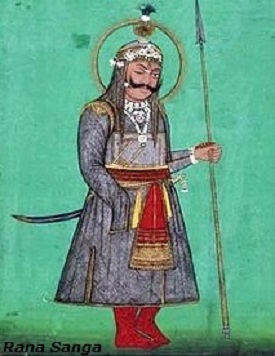
राणा सांगा युद्ध के मैदान से भाग निकले। बाद में वह (राणा) बाबर के साथ संघर्ष को फिर से शुरू करना चाहता था, लेकिन उसे अपने ही रईसों द्वारा जहर दिया गया था।
खानवा की लड़ाई ने दिल्ली-आगरा क्षेत्र में बाबर की स्थिति को मजबूत किया। बाद में, बाबर ने ग्वालियर, धौलपुर, आगरा के पूर्व, आदि सहित किलों की श्रृंखला पर विजय प्राप्त की।
बाबर ने हसन खान मेवाती से अलवर और मेदिनी राय से चंदेरी (मालवा) पर भी विजय प्राप्त की। लगभग सभी राजपूत रक्षकों को मारने के बाद चंदेरी पर कब्जा कर लिया गया था और उनकी महिलाओं ने जौहर किया था (यह राजपूत राज्यों की रानियों और शाही महिलाओं के आत्मदाह का रिवाज था)।
अफगानी
पूर्वी उत्तर प्रदेश, जो अफगान प्रमुखों के प्रभुत्व में था, ने बाबर के प्रति अपनी निष्ठा प्रस्तुत की थी, लेकिन आंतरिक रूप से इसे किसी भी समय फेंकने की योजना बनाई थी।
बंगाल के शासक नुसरत शाह, जिन्होंने इब्राहिम लोदी की बेटी से शादी की थी, ने अफगान सरदारों का समर्थन किया था।
अफगानों ने पूर्वी उत्तर प्रदेश में मुगल अधिकारियों को हटा दिया था और कई बार कन्नौज तक पहुंचे थे, लेकिन उनकी सबसे बड़ी कमजोरी एक सक्षम नेता की कमी थी।
अफगान नेताओं ने महमूद लोदी को आमंत्रित किया। वह (महमूद लोदी) इब्राहिम लोदी का भाई था और उसने खानवा में बाबर के खिलाफ भी लड़ाई लड़ी थी। अफगान नेताओं ने अपने शासक के रूप में उनका स्वागत किया, और उनके नेतृत्व में ताकत इकट्ठी की।
महमूद लोदी के नेतृत्व में अफगान बाबर के लिए एक बड़ा खतरा थे, जिसे वह (बाबर) नजरअंदाज नहीं कर सकता था। 1529 की शुरुआत में, बाबर ने पूर्व की ओर आगरा छोड़ दिया और उसने घाघरा नदी के पार अफगानों और बंगाल के नुसरत शाह की संयुक्त सेना का सामना किया।
जब बाबर (पूर्व में) अफ़गानों से लड़ रहा था, तब उसे एक संदेश मिला अर्थात् मध्य एशिया में संकट की स्थिति। इस प्रकार बाबर ने अफगानों के साथ एक समझौते के साथ युद्ध समाप्त करने का फैसला किया। उसने बिहार पर आधिपत्य का अस्पष्ट दावा किया और बड़े हिस्से को अफगानों के हाथों में छोड़ दिया।
26 दिसंबर, 1530 को जब बाबर काबुल (अफगानिस्तान) लौट रहा था, लाहौर के पास उसकी मृत्यु हो गई।
Following are the major battles that fought by Mughal emperor Babur
First Battle of Panipat
On 20th April 1526, the First Battle of Panipat, was fought between Babur and the Ibrahim Lodi Empire (ruler of Delhi). The battle took place in north India (Panipat) and marked as the beginning of the Mughal Empire.

The first battle of Panipat was one of the earliest battles in which gunpowder firearms and field artillery were used. However, Babur said that he used it for the first time in his attack on the Bhira fortress.
Ibrahim Lodi met Babur at Panipat with the force estimated at 100,000 men and 1,000 elephants.
Babur had crossed the Indus with a force of merely 12,000; however, in India, a large number of Hindustani nobles and soldiers joined Babur in Punjab. In spite of Indian army support, Babur's army was numerically inferior.
Babur made a master plan and strengthened his position. He ordered one of his army wings to rest in the city of Panipat, which had a large number of houses. Further, he protected another wing by means of a ditch filled with branches of trees.
On the front side, Babur lashed with a large number of cans, to act as a defending wall. Between two carts, breastworks were erected so that soldiers could rest their guns and fire.
Babur used the Ottoman (Rumi) device technique, which had been used by the Ottomans in their well-known battle against Shah Ismail of Iran.
Babur had also invited two Ottoman master-gunners namely Ustad Ali and Mustafa.
Ibrahim Lodi, however, with huge army men, could not assume the strongly defended position of Babur.
Ibrahim Lodi had apparently expected Babur to fight a mobile mode of warfare, which was common with the Central Asians.
Babur's gunners used their guns strategically with good effect from the front; however, Babur gave a large part of the credit of his victory to his bowmen.
After the seven or eight days fight, Ibrahim Lodi realized Babur’s strong position. Further, Lodi’s forces were also hesitant to fight with Babur’s modern technological warfare.
Ibrahim Lodi battled to the last with a group of 5,000 to 6,000 forces, but he (Lodi) had been killed in the battle field.
It is estimated that more than 15,000 men (of Lodi kingdom) were killed in the first battle of Panipat.
Battle of Khanwa
On March 17, 1527, the Battle of Khanwa was fought near the village of Khanwa (about 60 km west of Agra). It was fought between the first Mughal Emperor Babur and Rajput ruler Rana Sanga.
The Rajput ruler, Rana Sanga, was the great threat for Babur to establish a strong Mughal empire in the Indo-Gangetic Valley, as Sanga planned to expel Babur from India or else confined him at Punjab.
Babur had an authentic reason to accuse Rana Sanga i.e. of breach of an agreement. In fact, Sanga invited him (Babur) to India with a promise to fight with him against Ibrahim Lodi, but he (Rana) refused.
The battle of Khanwa was aggressively fought. As Babur reported, Sanga had more than 200,000 men including 10,000 Afghan cavalrymen, supported with an equal force fielded by Hasan Khan Mewati.
Babur’s strategy, in the battle ground, was highly technical; he ordered his soldiers (who had been sheltering behind their tripods) to attack in the center. Thus Sanga's forces were hemmed in, and finally defeated.

Rana Sanga escaped from the battle field. Later he (Rana) wanted to renew the conflict with Babur, but he was poisoned by his own nobles.
The battle of Khanwa strengthened Babur's position in the Delhi-Agra region. Later, Babur conquered the chain of forts including Gwalior, Dholpur, east of Agra, etc.
Babur also conquered Alwar from Hasan Khan Mewati and Chanderi (Malwa) from Medini Rai. Chanderi was captured after killing almost all the Rajput defenders men and their women performed jauhar (it was the custom of self-immolation of queens and royal female of the Rajput kingdoms).
The Afghans
Eastern Uttar Pradesh, which was under the domination of the Afghan chiefs had submitted their allegiance to Babur, but internally planned to throw it off at any time.
Nusrat Shah, the ruler of Bengal, who had married a daughter of Ibrahim Lodi, had supported the Afghan sardars.
The Afghans had ousted the Mughal officials in eastern Uttar Pradesh and reached up to Kanauj many times, but their major weakness was the lack of a competent leader.
Afghan leaders invited Mahmud Lodi. He (Mahmud Lodi) was a brother of Ibrahim Lodi and also had fought against Babur at Khanwa. The Afghan leaders welcomed him as their ruler, and congregated strength under his leadership.
The Afghans, under Mahmud Lodi’s leadership, was a great threat for Babur, which he (Babur) could not ignore. At the beginning of 1529, Babur left Agra for the east and he faced the combined forces of the Afghans and Nusrat Shah of Bengal at the crossing of the Ghagra River.
While Babur was fighting with the Afghans (in the east), he received a message i.e. crisis situation in Central Asia. Thus Babur decided to conclude the war with an agreement with the Afghans. He made a vague claim for the suzerainty over Bihar, and left the large parts in the Afghan’s hands.
On 26 December, 1530, when Babur was returning to Kabul (Afghanistan) died near Lahore.
मुगल सम्राट बाबुरी द्वारा लड़े गए प्रमुख युद्ध || Major battles fought by Mughal Emperor Baburi
जैसे-जैसे सल्तनत की शक्ति धीरे-धीरे कम होती गई, उपमहाद्वीप के विभिन्न हिस्सों में नए राज्यों की संख्या का उदय हुआ। उनमें से अधिकांश सल्तनत के प्रांतों के रूप में शुरू हुए, लेकिन बाद में स्वतंत्र प्रांत बन गए।
पश्चिमी भारत
पश्चिमी भारत में गुजरात और मालवा के राज्य थे। अहमदाबाद शहर की स्थापना करने वाले अहमद शाह ने गुजरात की शक्ति को मजबूत किया था।
हुशांग शाह के शासनकाल के दौरान, मालवा क्षेत्र महत्वपूर्ण और शक्तिशाली बन गया। हुशांग शाह ने मांडू के खूबसूरत किले शहर का निर्माण किया।
हालाँकि, गुजरात और मालवा अक्सर एक-दूसरे के साथ युद्ध में रहते थे, जिससे वास्तव में उनकी शक्ति कम हो जाती थी।
राजपूतों
मेवाड़ और मारवाड़ नाम के दो महत्वपूर्ण राजपूत राज्य थे। ये दोनों बार-बार एक दूसरे के साथ युद्ध में थे। इस तथ्य के बावजूद कि दोनों शाही परिवारों के बीच वैवाहिक संबंध थे।
मेवाड़ के राणा कुम्भा इस समय के शक्तिशाली शासक थे। वह एक कवि, संगीतकार और शक्तिशाली शासक होने के कारण कई रुचियों के व्यक्ति थे।
इस काल में राजस्थान में कई अन्य राज्यों का उदय हुआ था, बीकानेर उनमें से एक था।
उत्तर भारत
उत्तर भारत में, कश्मीर राज्य प्रमुखता में आया। ज़ैन-उल-अबिदीन, जिसे पंद्रहवीं शताब्दी के शासक 'बड शाह' (महान राजा) के नाम से भी जाना जाता है, इस काल का सबसे लोकप्रिय नाम था।
ज़ैन-उल-अबिदीन ने फारसी और संस्कृत दोनों के लिए छात्रवृत्ति को प्रोत्साहित किया। वह अपने समय के एक लोकप्रिय शासक थे, क्योंकि उनकी प्रमुख नीतियां लोगों के कल्याण के बारे में चिंतित थीं।
पूर्वी भारत
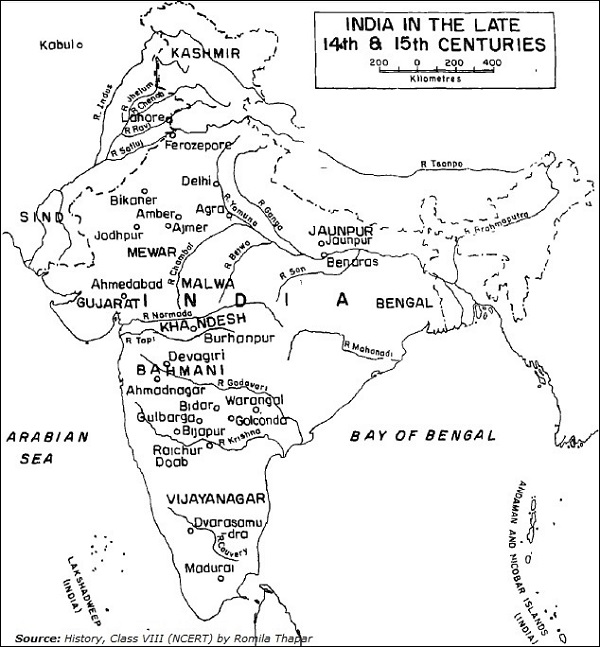
जौनपुर और बंगाल, ये दोनों पूर्वी भारत के महत्वपूर्ण क्षेत्र थे। इन दोनों की स्थापना दिल्ली सुल्तान के राज्यपालों ने की थी जिन्होंने बाद में सल्तनत के खिलाफ विद्रोह कर दिया था।
जौनपुर पर शर्की राजाओं का शासन था। उसकी बड़ी महत्वाकांक्षा थी यानी दिल्ली पर कब्जा करना, जो कभी नहीं हुआ। बाद में जौनपुर हिंदी साहित्य और शिक्षा का एक महत्वपूर्ण केंद्र बन गया।
बंगाल पर विभिन्न जातियों के राजाओं का शासन था; हालाँकि, बड़े पैमाने पर तुर्क और अफगान थे। ये सभी राजा स्थानीय संस्कृति के संरक्षक थे और बंगाली भाषा के प्रयोग को प्रोत्साहित करते थे।
दक्षिण भारत
बहमनी और विजयनगर दक्षिण भारत के दक्कन क्षेत्रों में महत्वपूर्ण राज्य थे। ये दोनों राज्य मुहम्मद-बिन-तुगलक के काल में उत्पन्न हुए थे।
बहमनी साम्राज्य
बहमनी और विजयनगर, इन दोनों राज्यों की स्थापना सल्तनत के अधिकारियों ने की थी जिन्होंने सुल्तान के खिलाफ विद्रोह किया था।
हसन ने सुल्तान के खिलाफ विद्रोह का नेतृत्व किया और बहमनी साम्राज्य की स्वतंत्रता की घोषणा की। उन्होंने बहमन शाह की उपाधि धारण की।
बहमनी साम्राज्य में कृष्णा नदी तक का पूरा उत्तरी दक्कन शामिल था (जैसा कि ऊपर दिए गए नक्शे में दिखाया गया है)।
विजयनगर साम्राज्य
विजयनगर साम्राज्य की स्थापना दो भाइयों हरिहर और बुक्का ने की थी ।
1336 में, हरिहर और बुक्का ने होयसल (यानी आधुनिक मैसूर राज्य) के क्षेत्र पर विजय प्राप्त की और खुद को विजयनगर साम्राज्य के एक स्वतंत्र शासक के रूप में घोषित किया।
हरिहर और बुक्का ने हस्तिनावती (आधुनिक हम्पी) को अपनी राजधानी बनाया।
इन बड़े राज्यों के अलावा, कई अन्य छोटे राज्य भी थे, खासकर पूर्वी तट के किनारे (उड़ीसा से तमिलनाडु तक)। इन छोटे राज्यों पर अक्सर बहमनी या विजयनगर शासकों द्वारा हमला किया जा रहा था।
1370 में, विजयनगर ने मदुरै पर विजय प्राप्त की। यह पश्चिमी तट पर भी सक्रिय था। इस बीच, बहमनी साम्राज्य अपने उत्तरी पड़ोसियों, अर्थात् गुजरात और मालवा के राज्यों के खिलाफ लड़ने में लगा हुआ था।
उपमहाद्वीप के ये सभी राज्य भू-राजस्व और व्यापार के माध्यम से आने वाली अच्छी आय के कारण शक्तिशाली हो गए।
गुजरात और बंगाल को विशेष रूप से पश्चिमी एशिया, पूर्वी अफ्रीका, दक्षिण-पूर्व एशिया और चीन के साथ विदेशी व्यापार से बड़ा लाभ प्राप्त हुआ।
बहमनी और विजयनगर राज्यों ने भी विदेशी व्यापार में भाग लिया।
इन राज्यों में व्यापार के अलावा, स्थानीय संस्कृति, क्षेत्रीय भाषा में साहित्य, वास्तुकला, पेंटिंग और नए धार्मिक विचारों का विकास हुआ।
As the power of the Sultanate gradually declined, the number of new kingdoms arose in different parts of the subcontinent. Most of them began as provinces of the Sultanate, but later became independent province.
Western India
In western India, there were the kingdoms of Gujarat and Malwa. Ahmed Shah who founded the city of Ahmadabad, had strengthened the power of Gujarat.
During the reign of Hushang Shah, Malwa region became important and powerful. Hushang Shah built the beautiful fortress city of Mandu.
Gujarat and Malwa, however, were frequently at war with each other, which in reality reduced their power.
The Rajputs
There were two important Rajput kingdoms, namely Mewar and Marwar. These two were recurrently at war with each other. In spite of the fact that the two royal families had marriage relations.
Rana Kumbha of Mewar was the powerful ruler of this time. He was a man of many interests, as he was a poet, musician, and powerful ruler.
During the period, many other kingdoms had been risen in Rajasthan, Bikaner was one of them.
North India
In the north India, the kingdom of Kashmir came into prominence. Zain-ul-Abidin, also known as 'Bud Shah' (the great king) the ruler of the fifteenth century, was the most popular name of this period.
Zain-ul-Abidin encouraged the scholarship for both Persian and Sanskrit. He was a popular ruler of his time, as his major policies were concerned about the welfare of the people.
Eastern India

Jaunpur and Bengal, these two were the important regions of the Eastern India. Both of these were founded by governors of the Delhi Sultan who had later rebelled against the Sultanate.
Jaunpur was ruled by the Sharqi kings. He had a great ambition i.e. to capture Delhi, which never happened. Later, Jaunpur became an important center of Hindi literature and learning.
Bengal was ruled by kings of different races; however, largely were Turks and Afghans. All these kings were patrons of local culture and encouraged the use of the Bengali language.
South India
Bahamani and Vijayanagar were the significant kingdoms in the Deccan regions of south India. These two kingdoms had been arisen during the period of Muhammad-bin-Tughlaq.
Bahamani Kingdom
Bahamani and Vijayanagar, both these kingdoms were founded by officers of the Sultanate who had rebelled against the Sultan.
Hasan led a rebellion against the Sultan and proclaimed the independence of the Bahmani kingdom. He took the title of Bahman Shah.
The Bahmani kingdom included the whole of the northern Deccan up to the river Krishna (as shown in the map given above).
Vijayanagara Kingdom
Vijayanagara Kingdom was founded by two brothers Harihara and Bukka.
In 1336, Harihara and Bukka conquered the territory of the Hoysala (i.e. modern Mysore State) and proclaimed themselves as an Independent ruler of the Vijayanagara Kingdom.
Harihara and Bukka made Hastinavati (modern Hampi) their capital.
Apart from these big kingdoms, there were many other smaller kingdoms, especially along the eastern coast (from Orissa to Tamil Nadu). These smaller kingdoms were being frequently attacked by either the Bahmanis or the Vijayanagara rulers.
In 1370, Vijayanagara conquered Madurai. It was also active on the west coast. Meanwhile, the Bahmani kingdom was engaged in fighting against its northern neighbors, namely the kingdoms of Gujarat and Malwa.
All these kingdoms of the subcontinent became powerful, because of the handsome income that came through the land revenue and trade.
Gujarat and Bengal received big profits from overseas trade especially with western Asia, East Africa, South-East Asia, and China.
The Bahmani and Vijaynagara kingdoms also took part in the overseas trade.
Besides trade, local culture, literature in the regional language, architecture, paintings, and new religious ideas were developed in these kingdoms.
इंडिया की नई सल्तनत || New Kingdom of India
भारत में इस्लाम के आगमन के बाद धार्मिक व्यवहार में भी कुछ परिवर्तन देखे जा सकते हैं। धार्मिक विचारों (विशेषकर हिंदू और मुस्लिम धर्म) का आदान-प्रदान किया गया। हालांकि, धार्मिक प्रवृत्तियों के संदर्भ में, निम्नलिखित दो आंदोलन सबसे अधिक ध्यान देने योग्य हैं -
सूफी आंदोलन और
भक्ति आंदोलन
सूफी आंदोलन
ग्यारहवीं शताब्दी के दौरान, कुछ मुसलमान (विशेषकर जो फारस और आसपास के क्षेत्रों से आए थे) मूल रूप से सूफी थे । वे भारत के विभिन्न हिस्सों में बस गए और जल्द ही बहुत सारे भारतीय अनुयायियों को इकट्ठा कर लिया।
सूफी विचारधारा ने प्रेम और भक्ति को ईश्वर के करीब आने के साधन के रूप में बढ़ावा दिया। सच्चे भगवान के भक्त भगवान और अपने साथी पुरुषों के करीब (दोनों) आए। दूसरे, सूफियों ने सुझाव दिया कि प्रार्थना, उपवास और अनुष्ठान ईश्वर के सच्चे प्रेम के समान महत्वपूर्ण नहीं थे।
सूफी, जब वे भगवान और साथी पुरुषों के लिए सच्चे प्यार को बढ़ावा दे रहे थे, वे अन्य सभी धर्मों और संप्रदायों के लिए काफी लचीले और सहिष्णु थे, और उन्होंने वकालत की कि भगवान के रास्ते कई हो सकते हैं।
सूफियों ने आगे, सभी मनुष्यों के लिए सम्मान को बढ़ावा दिया। यही कारण था कि रूढ़िवादी उलेमा ने सूफियों की विचारधारा को स्वीकार नहीं किया और कहा कि सूफी शिक्षाएं रूढ़िवादी इस्लाम के अनुरूप नहीं थीं।
कई हिंदू भी सूफी संतों का सम्मान करते थे और अनुयायी बन गए। हालाँकि, सूफियों ने हिंदुओं को धोखा देने या इस्लाम में परिवर्तित करने का प्रयास नहीं किया, बल्कि हिंदुओं को एक सच्चे ईश्वर से प्यार करके बेहतर हिंदू बनने की सलाह दी।
सबसे लोकप्रिय सूफी संतों में से एक मुइन-उद-दीन चिश्ती थे । उन्होंने अपना अधिकांश जीवन अजमेर शहर में बिताया (जहाँ उनकी मृत्यु 1236 में हुई थी)।
मुईन-उद-दीन चिश्ती ने भक्ति संगीत पर जोर दिया और कहा कि भक्ति संगीत ईश्वर के करीब जाने का एक तरीका है।
उलेमा ने संगीत को धर्म या ईश्वर से जोड़ने की स्वीकृति नहीं दी । हालाँकि, चिश्ती के अनुयायियों ने उन जगहों पर सभाएँ कीं जहाँ कुछ बेहतरीन संगीत सुने जा सकते थे।
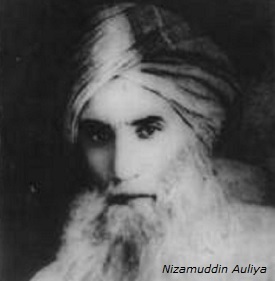
कव्वाली सूफी सभाओं में गायन का एक जाना-पहचाना रूप था । हिंदी में गाए गए कुछ गीत भी लोकप्रिय थे।
अजोधन (अब पाकिस्तान में) में रहने वाले बाबा फरीद भी एक लोकप्रिय सूफी संत थे।
निजाम-उद-दीन औलिया सूफी संत थे जिन्हें सुल्तानों और जनता दोनों से प्यार था। उनका सेंटर दिल्ली के पड़ोस में था।
निज़ाम-उद-दीन औलिया एक बहादुर और ईमानदार व्यक्ति थे और उन्होंने अपने स्वतंत्र दिमाग से वकालत की। यदि निजामुद्दीन औलिया को सुल्तान तक की कोई कार्रवाई पसंद नहीं आती थी, तो उसने ऐसा कहा और अन्य लोगों की तरह डरे नहीं।
भक्ति आंदोलन
सातवीं शताब्दी के दौरान, भक्ति आंदोलन देश के दक्षिण भाग (विशेषकर तमिल भाषी क्षेत्रों में) में विकसित हुआ। कालांतर में यह सभी दिशाओं में फैल गया।
तमिल भक्ति पंथ के अलवर और नयनार ने भजनों और कहानियों के माध्यम से भक्ति के विचार का प्रचार करने की परंपरा शुरू की थी ।
भक्ति आंदोलन के अधिकांश संत गैर-ब्राह्मण परिवारों से थे।
सूफी विचारधारा की तरह, भक्ति विचारधारा ने भी सिखाया कि मनुष्य और ईश्वर के बीच का संबंध प्रेम पर आधारित है, और भक्ति के साथ ईश्वर की पूजा करना केवल कई धार्मिक समारोहों को करने से बेहतर है। भक्ति संतों ने पुरुषों और धर्मों के बीच सहिष्णुता पर जोर दिया।
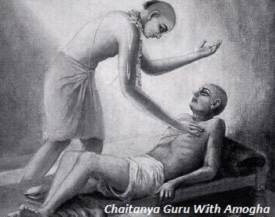
कृष्ण के भक्त चैतन्य एक धार्मिक शिक्षक थे जिन्होंने बंगाल में उपदेश दिया था। उन्होंने कृष्ण को समर्पित कई भजनों की रचना की।
चैतन्य ने देश के विभिन्न हिस्सों की यात्रा की थी और अपने अनुयायियों के एक समूह को इकट्ठा किया था। अपने जीवन के अंत में, वह उड़ीसा के पुरी में बस गए।
महाराष्ट्र में भक्ति विचारधारा का प्रचार ज्ञानेश्वर ने किया था। ज्ञानेश्वर ने गीता का मराठी में अनुवाद किया था।
नामदेव और बाद के काल में, तुकाराम , भक्ति आंदोलन के बहुत लोकप्रिय संत थे।
कबीर , जो मूल रूप से एक बुनकर थे, एक भक्ति संत (बनारस में) भी थे। दोहे (या दोहे), जिन्हें कबीर ने अपने अनुयायियों को रचा और प्रचारित किया, अभी भी पढ़े जाते हैं ।
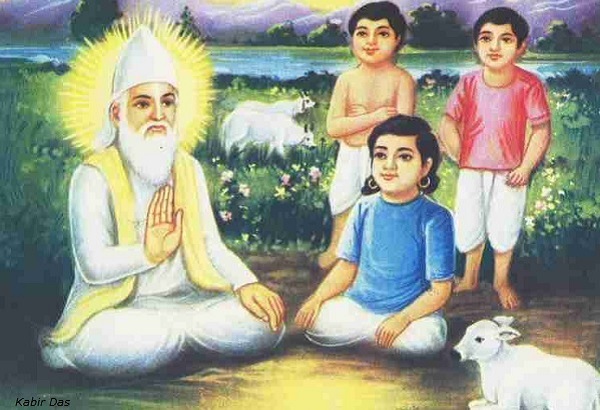
कबीर ने महसूस किया कि धार्मिक मतभेद मायने नहीं रखते, क्योंकि वास्तव में जो मायने रखता है वह यह है कि सभी को ईश्वर से प्रेम करना चाहिए। भगवान के कई नाम हैं (जैसे राम, रहीम, आदि)। इसलिए, उन्होंने दो धर्मों, अर्थात् हिंदू धर्म और इस्लाम के बीच एक सेतु बनाने की कोशिश की।
कबीर के अनुयायियों ने एक अलग समूह बनाया था, जो कबीरपंथियों के नाम से लोकप्रिय था । बाद में, सूरदास और दादू ने भक्ति परंपरा को जारी रखा।
After the arrival of Islam in India, some changes can be seen in religious practice as well. Religious ideas (especially Hindu and Muslim religions) were exchanged. However, in context of religious trends, the following two movements are the most noticeable −
Sufi Movement and
Bhakti Movement
Sufi Movement
During the eleventh century, some of the Muslims (especially who had come from Persia and nearby regions) were fundamentally Sufis. They settled in different parts of India and soon gathered plenty of Indian followers.
The Sufi ideology promoted love and devotion as means of coming nearer to God. The true God’s devotees bound to came close (both) to God and to one's fellow men. Secondly, Sufis suggested that prayers, fasts, and rituals were not as important as the true love of God.
The Sufis, as they were promoting true love to God and fellow men, they were pretty flexible and tolerant for all other religions and sects, and advocated that the paths to God can be many.
The Sufis, further, promoted respect for all human beings. This was the reason that the orthodox Ulema did not approve of the ideology of Sufis and said that Sufi teachings were not in agreement with orthodox Islam.
Many of the Hindus also respected the Sufi saints and became followers. However, the Sufis did not attempt to deceive or convert Hindus to Islam, but rather advised Hindus to be better Hindus by loving the one true God.
One of the most popular Sufi saints was Muin-ud-din Chishti. He lived most of his life in the city of Ajmer (where he died in 1236).
Muin-ud-din Chishti emphasized on the devotional music and said that the devotional music is one of the ways to go closer to the God.
The Ulema did not approve of linking music with religion or God. However, Chishti's followers held gatherings at the places where some of the finest music could be heard.

The qawwali was a familiar form of singing at the sufi gatherings. Some songs sung in Hindi were also popular.
Baba Farid who lived at Ajodhan (now in Pakistan) was also a popular Sufi saint.
Nizam-ud-din Auliya was the Sufi saint who was loved by both the Sultans and by the public. His center was in the neighborhood of Delhi.
Nizam-ud-din Auliya was a brave and honest man and he advocated with his free mind. If Nizam-ud-din Auliya did not like any action of even the Sultan, he said so and was not afraid as were so many other people.
The Bhakti Movement
During the seventh century, Bhakti movement evolved in the south part of the country (especially in the Tamil speaking regions). Over a period of time, it spread in all the directions.
The alvars and the nayannars of the Tamil devotional cult had started the tradition of preaching the idea of bhakti through hymns and stories.
Most of the saints of Bhakti movement were from the non-Brahman families.
Like Sufi ideology, the bhakti ideology also taught that the relationship between man and God was based on love, and worshipping God with devotion was better than merely performing any number of religious ceremonies. Bhakti Saints emphasized on the tolerance among men and religions.

Chaitanya, the devotee of Krishna, was a religious teacher who preached in Bengal. He composed many hymns dedicated to Krishna.
Chaitanya had traveled different parts of the country and gathered a group of his followers. At the end of his life, he settled at Puri in Orissa.
In Maharashtra, the Bhakti ideology was preached by Jnaneshvara. Jnaneshvara had translated Gita in Marathi.
Namadeva and in a later period, Tukaram, were the pretty popular saints of Bhakti movement.
Kabir, who was basically a weaver, was also a Bhakti saint (in Banaras). The dohas (or couplets), which Kabir composed and preached to his followers are still recited.

Kabir realized that religious differences do not matter, for what really matters is that everyone should love God. God has many names (e.g. Ram, Rahim, etc.). Therefore, he tried to make a bridge between the two religions, namely Hinduism and Islam.
The followers of Kabir had formed a separate group, popular as Kabirpanthis. Later, Surdas and Dadu continued the bhakti tradition.
जानिए कैसे भारत में इस्लाम के आने के बाद धामों में झगड़े बड़े || Know how after the arrival of Islam in India, the fights in the Dhams got bigger
Introduction
In the fourteenth century, the disintegration of the Mongol empire led Timur to unite Iran and Turan under one rule.
Timur's empire was spread from the lower Volga to the river Indus, including Iran, Asia Minor (modern Turkey), Trans-Oxiana, Afghanistan, and some part of Punjab.
In 1404, Timur died and Shahrukh Mirza, his grandson, succeeded his empire.
Timur gave patronage to arts and letters and he promoted Samarqand and Herat as the cultural centers of West Asia.
During the second half of the fifteenth century, the power of Timurids declined, largely because of the Timurid practice of partitioning of the empire.
The various Timund territories that developed during his time, were kept fighting and backbiting to each other. Their conflicting acts gave an opportunity to two new powers to come to the forefront −
The Uzbeks − In the north, the Uzbeks thrust into Trans-Oxiana. Though the Uzbeks had become Muslims, but Timurids looked them down because they (Timurids) considered them to be uncultured barbarians.
Safavid Dynasty − In the west (i.e. Iran), the Safavid dynasty appeared. They were descended from an order of saints who traced their ancestry to the Prophet.
Safavids dynasty promoted the Shi’ite sect among the Muslims, and persecuted to all those who were not ready to accept the Shia views.
The Uzbeks, on the other hand, were Sunnis. Thus, the political conflict between these two elements was estranged on the basis of sectarian views.
The power of the Ottoman Turks had escalated in the west of Iran and they wanted to rule Eastern Europe as well as Iran and Iraq.
Zahiruddin Muhammad Babur
In 1494, Babur, at the young age of merely 14, succeeded to Farghana. Farghana was a small state in Trans-Oxiana.
Shaibani Khan, the Uzbek chief, defeated Babur and conquered Samarqand.
Shaibani Khan, in a short span of time, besieged the most of the Timurid kingdoms and forced Babur to move towards Kabul.
In 1504, Babur conquered Kabul; at that time, Kabul was under the rule of the infant heir of Ulugh Begh.
Almost 15 years, Babur struggled hard and kept attempting to re-conquest his homeland from the Uzbeks. He approached the ruler of Herat (who was also his uncle) for the help, but he did not receive any positive response.
Shaibani Khan defeated Herat, which led to a direct conflict between the Uzbeks and the Safavids because Safavids was also claiming Herat and its surrounding area, namely Khorasan.
In the battle of 1510, Shaibani Khan defeated and killed by Kasim Khan.
By taking the help of Iranian power, Babur attempted to recover Samarqand. As a result of this, the Iranian generals wanted to treat Babur as the governor of an Iran rather than as an independent ruler.
After the massive defeat, the Uzbeks swiftly recovered; resultantly, Babur had been overthrown again from Samarqand and he had to return back to Kabul.
Shah Ismail (Shah of Iran) was defeated in a battle by the Ottoman sultan; the changes in geo-political scenario forced Babur to move towards India.
Once Babur said that from the time he won Kabul (i.e. in 1504) to his victory of Panipat, he had never ceased to think of the conquest of Hindustan.
Timur, the ancestor of Babur, had carried away a vast treasure along with many skilful artisans from India. The artisans helped Timur to consolidate his Asian empire and beautify the capital. They (the artisans) also helped Timur to annex some areas of Punjab.
Reasons of India Conquest
Abul Fazl, the contemporary historian said that "Babur ruled over Badakhshan, Qandhar, and Kabul which did not yield sufficient income for the requirements of his army; in fact, in some of the border territories, the expense on controlling the armies and administration was greater than the income".
Babur was also always remained apprehensive about an Uzbek attack on his territory Kabul, and hence, considered India to be a safe place of refuge, as well as a suitable base for operations against the Uzbeks.
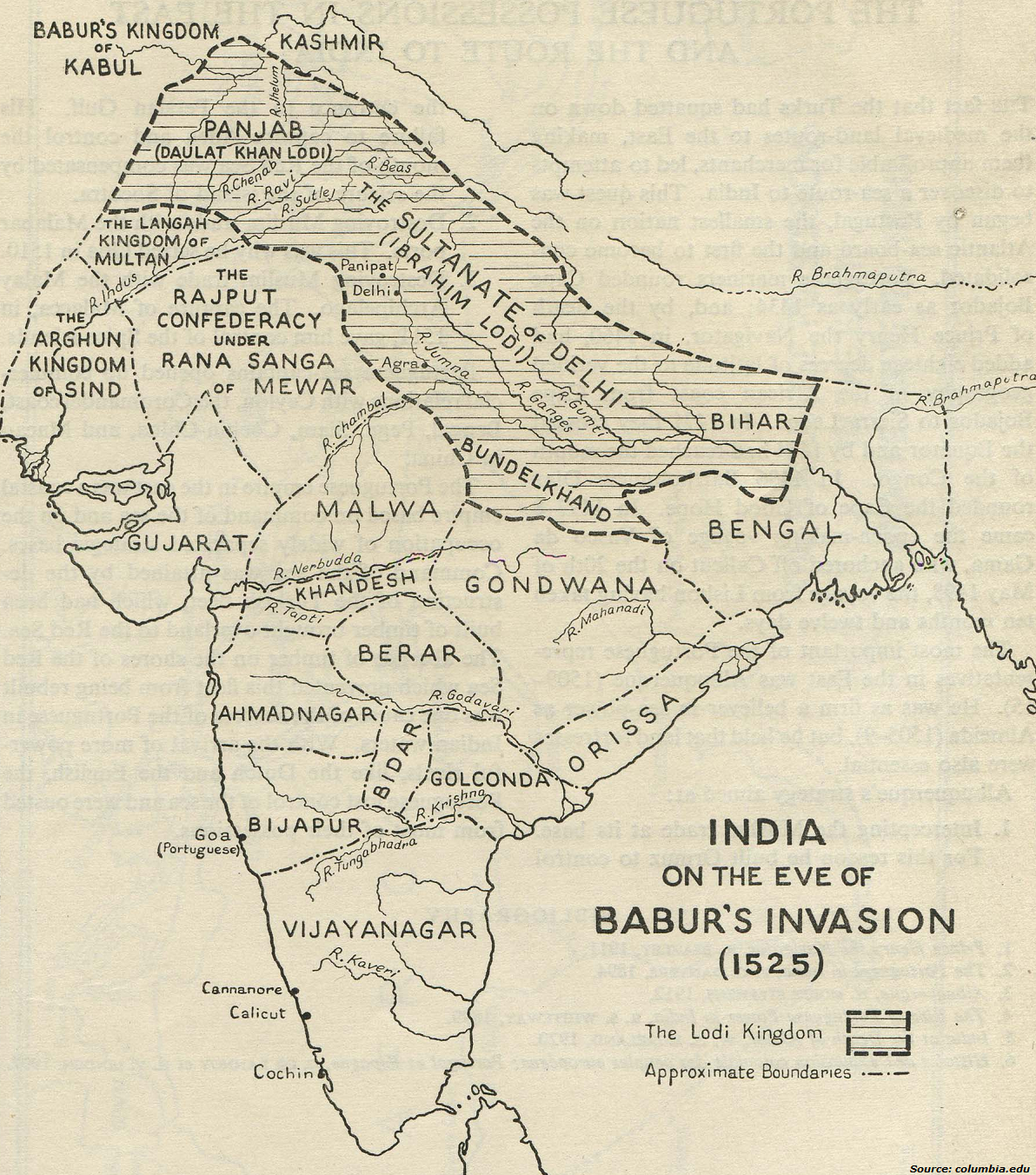
By the time, the political scenario of north-west India was much suitable for Babur's entry (into India).
In 1517, Sikandar Lodi had died and Ibrahim Lodi (his son) had succeeded him.
Ibrahim Lodi was an ambitious emperor whose efforts to build a large centralized empire had alarmed the Afghan chief as well as the Rajputs.
Daulat Khan Lodi was one of the most powerful chiefs of his time. Though, he was the governor of Punjab, but he was almost an Independent ruler.
Daulat Khan wanted to conciliate with Ibrahim Lodi; therefore, he sent his son to his (Ibrahim’s) court to pay homage. However, he was also intended to strengthen his power by annexing the frontier tracts of Bhira.
In 1518-19, Babur seized the powerful fort of Bhira and sent letters as well as verbal messages to Ibrahim Lodi and Daulat Khan. Babur asked them for the cession of all those areas, which had belonged to the Turks.
Daulat Khan detained Babur's envoy at Lahore, neither granted him audience nor allowed him to go and meet Ibrahim Lodi. Daulat Khan expelled Babur’s agent from Bhira.
Once again in 1520-21, Babur crossed the Indus, and easily clutched Bhira and Sialkot (popular as the twin gateways to Hindustan) and then, Lahore was also surrendered to him.
After capturing Bhira and Sialkot, Babur planned to proceed further, but because of the revolt in Qandhar, he returned back.
Babur recaptured Qandhar after almost one and half years. His political stability again encouraged him to move towards India.
Daulat Khan sent Dilawar Khan (his son) to Babur’s court and invited Babur to come India. Daulat Khan suggested Babur to replace Ibrahim Lodi, as he (Ibrahim Lodi) was a tyrant ruler.
Rana Sanga (Rana of Mewar), most likely at the same time, also sent a message to Babur inviting him to attack India. Two embassies from the powerful kingdom convinced Babur to conquest India again.
In 1525, when Babur was in Peshawar, he received a message that Daulat Khan Lodi had changed the sides.
Daulat Khan had collected an army of 30,000-40,000 men and ousted Babur's soldiers from Sialkot, and tried to advance towards Lahore. However, as Babur came, Daulat Khan’s army ran away; resultantly, Daulat Khan got surrendered and was pardoned. Babur became the ruler of Punjab.
परिचय
चौदहवीं शताब्दी में, मंगोल साम्राज्य के विघटन ने तैमूर को एक शासन के तहत ईरान और तूरान को एकजुट करने के लिए प्रेरित किया।
तैमूर का साम्राज्य निचले वोल्गा से सिंधु नदी तक फैला हुआ था, जिसमें ईरान, एशिया माइनर (आधुनिक तुर्की), ट्रांस-ऑक्सियाना, अफगानिस्तान और पंजाब का कुछ हिस्सा शामिल था।
1404 में, तैमूर की मृत्यु हो गई और उनके पोते शाहरुख मिर्जा ने उनके साम्राज्य का उत्तराधिकारी बना लिया।
तैमूर ने कला और पत्रों को संरक्षण दिया और उन्होंने समरकंद और हेरात को पश्चिम एशिया के सांस्कृतिक केंद्रों के रूप में बढ़ावा दिया।
पंद्रहवीं शताब्दी के उत्तरार्ध के दौरान, तैमूरिड की शक्ति में गिरावट आई, मुख्यतः साम्राज्य के विभाजन के तैमूर अभ्यास के कारण।
उसके समय में विकसित हुए विभिन्न तिमुंड प्रदेशों को आपस में लड़ते-लड़ते और पीछे-पीछे करते रहते थे। उनके परस्पर विरोधी कृत्यों ने दो नई शक्तियों को आगे आने का अवसर दिया -
उज्बेक्स - उत्तर में, उज्बेक्स ट्रांस-ऑक्सियाना में घुस गए। हालाँकि उज़्बेक मुसलमान हो गए थे, लेकिन तैमूरिडों ने उन्हें नीचा देखा क्योंकि वे (तिमुरीद) उन्हें असभ्य बर्बर मानते थे।
सफविद राजवंश - पश्चिम (यानी ईरान) में सफविद राजवंश प्रकट हुआ। वे संतों के एक आदेश के वंशज थे जिन्होंने पैगंबर को अपने वंश का पता लगाया था।
सफ़ाविद वंश ने मुसलमानों के बीच शिया संप्रदाय को बढ़ावा दिया, और उन सभी को सताया जो शिया विचारों को स्वीकार करने के लिए तैयार नहीं थे।
दूसरी ओर, उज़्बेक सुन्नी थे। इस प्रकार, सांप्रदायिक विचारों के आधार पर इन दोनों तत्वों के बीच राजनीतिक संघर्ष को अलग कर दिया गया था।
तुर्क तुर्कों की शक्ति ईरान के पश्चिम में बढ़ गई थी और वे पूर्वी यूरोप के साथ-साथ ईरान और इराक पर भी शासन करना चाहते थे।
जहीरुद्दीन मुहम्मद बाबुरी
1494 में, बाबर महज 14 साल की छोटी उम्र में फरगना में सफल हुआ। फरगना ट्रांस-ऑक्सिआना में एक छोटा सा राज्य था।
उज़्बेक प्रमुख शैबानी खान ने बाबर को हराकर समरकंद पर विजय प्राप्त की।
शैबानी खान ने बहुत कम समय में तैमूर के अधिकांश राज्यों को घेर लिया और बाबर को काबुल की ओर बढ़ने के लिए मजबूर कर दिया।
1504 में, बाबर ने काबुल पर विजय प्राप्त की; उस समय, काबुल उलुग बेग के शिशु उत्तराधिकारी के शासन में था।
लगभग 15 वर्षों तक, बाबर ने कठिन संघर्ष किया और उज्बेक्स से अपनी मातृभूमि को फिर से जीतने का प्रयास करता रहा। उसने मदद के लिए हेरात के शासक (जो उसके चाचा भी थे) से संपर्क किया, लेकिन उसे कोई सकारात्मक प्रतिक्रिया नहीं मिली।
शैबानी खान ने हेरात को हराया, जिसके कारण उज्बेक्स और सफविद के बीच सीधा संघर्ष हुआ क्योंकि सफविद भी हेरात और उसके आसपास के क्षेत्र, अर्थात् खुरासान पर दावा कर रहे थे।
1510 के युद्ध में कासिम खाँ ने शैबानी खाँ को पराजित कर मारा।
बाबर ने ईरानी शक्ति की सहायता से समरकंद को पुनः प्राप्त करने का प्रयास किया। इसके परिणामस्वरूप, ईरानी सेनापति बाबर को एक स्वतंत्र शासक के रूप में नहीं बल्कि एक ईरान के गवर्नर के रूप में मानना चाहते थे।
भारी हार के बाद, उज्बेक्स तेजी से ठीक हो गए; परिणामस्वरूप, बाबर को समरकंद से फिर से उखाड़ फेंका गया और उसे वापस काबुल लौटना पड़ा।
शाह इस्माइल (ईरान का शाह) तुर्क सुल्तान द्वारा एक युद्ध में पराजित हुआ था; भू-राजनीतिक परिदृश्य में परिवर्तन ने बाबर को भारत की ओर बढ़ने के लिए मजबूर किया।
एक बार बाबर ने कहा था कि जब से उसने काबुल जीता (अर्थात 1504 में) पानीपत की अपनी जीत के लिए, उसने कभी भी हिंदुस्तान की विजय के बारे में सोचना बंद नहीं किया।
बाबर के पूर्वज तैमूर ने भारत से कई कुशल कारीगरों के साथ एक विशाल खजाना ले लिया था। कारीगरों ने तैमूर को अपने एशियाई साम्राज्य को मजबूत करने और राजधानी को सुशोभित करने में मदद की। उन्होंने (कारीगरों) ने तैमूर को पंजाब के कुछ इलाकों पर कब्जा करने में भी मदद की।
भारत विजय के कारण
समकालीन इतिहासकार अबुल फजल ने कहा कि " बाबर ने बदख्शां, कंधार और काबुल पर शासन किया, जिससे उसकी सेना की आवश्यकताओं के लिए पर्याप्त आय नहीं हुई; वास्तव में, कुछ सीमावर्ती क्षेत्रों में, सेनाओं और प्रशासन को नियंत्रित करने पर खर्च किया गया था। आय से अधिक" ।
बाबर हमेशा अपने क्षेत्र काबुल पर उज़्बेक हमले के बारे में आशंकित रहता था, और इसलिए, भारत को शरण का एक सुरक्षित स्थान माना जाता था, साथ ही साथ उज़्बेकों के खिलाफ कार्रवाई के लिए उपयुक्त आधार भी माना जाता था।

उस समय तक, उत्तर-पश्चिम भारत का राजनीतिक परिदृश्य बाबर के प्रवेश (भारत में) के लिए काफी उपयुक्त था।
1517 में, सिकंदर लोदी की मृत्यु हो गई थी और इब्राहिम लोदी (उसका पुत्र) उसका उत्तराधिकारी बना था।
इब्राहिम लोदी एक महत्वाकांक्षी सम्राट था जिसके एक बड़े केंद्रीकृत साम्राज्य के निर्माण के प्रयासों ने अफगान प्रमुख के साथ-साथ राजपूतों को भी चिंतित कर दिया था।
दौलत खान लोदी अपने समय के सबसे शक्तिशाली प्रमुखों में से एक थे। हालाँकि, वह पंजाब का राज्यपाल था, लेकिन वह लगभग एक स्वतंत्र शासक था।
दौलत खान इब्राहिम लोदी के साथ समझौता करना चाहता था; इसलिए, उसने अपने बेटे को श्रद्धांजलि देने के लिए अपने (इब्राहिम के) दरबार में भेजा। हालाँकि, उनका इरादा भीरा के सीमावर्ती इलाकों पर कब्जा करके अपनी शक्ति को मजबूत करने का था।
1518-19 में, बाबर ने भीरा के शक्तिशाली किले पर कब्जा कर लिया और इब्राहिम लोदी और दौलत खान को पत्र और मौखिक संदेश भेजे। बाबर ने उनसे उन सभी क्षेत्रों पर अधिकार करने के लिए कहा, जो तुर्कों के थे।
दौलत खान ने लाहौर में बाबर के दूत को हिरासत में लिया, न तो उसे दर्शकों की अनुमति दी और न ही उसे इब्राहिम लोदी से मिलने जाने दिया। दौलत खान ने बाबर के एजेंट को भीरा से निकाल दिया।
एक बार फिर 1520-21 में, बाबर ने सिंधु को पार किया, और आसानी से भीरा और सियालकोट ( हिंदुस्तान के लिए जुड़वां प्रवेश द्वार के रूप में लोकप्रिय) को पकड़ लिया। रूप में लोकप्रिय ) को पकड़ लिया और फिर, लाहौर को भी उसके सामने आत्मसमर्पण कर दिया गया।
भीरा और सियालकोट पर कब्जा करने के बाद, बाबर ने आगे बढ़ने की योजना बनाई, लेकिन कंधार में विद्रोह के कारण, वह वापस लौट आया।
बाबर ने लगभग डेढ़ वर्ष बाद कंधार पर पुनः अधिकार कर लिया। उनकी राजनीतिक स्थिरता ने उन्हें फिर से भारत की ओर बढ़ने के लिए प्रोत्साहित किया।
दौलत खान ने दिलावर खान (उनके बेटे) को बाबर के दरबार में भेजा और बाबर को भारत आने के लिए आमंत्रित किया। दौलत खान ने बाबर को इब्राहिम लोदी की जगह लेने का सुझाव दिया, क्योंकि वह (इब्राहिम लोदी) एक अत्याचारी शासक था।
राणा साँगा (मेवाड़ के राणा) ने भी संभवतः उसी समय बाबर को भारत पर आक्रमण करने के लिए आमंत्रित करने का संदेश भेजा था। शक्तिशाली साम्राज्य के दो दूतावासों ने बाबर को फिर से भारत पर विजय प्राप्त करने के लिए मना लिया।
1525 में, जब बाबर पेशावर में था, उसे एक संदेश मिला कि दौलत खान लोदी ने पक्ष बदल दिया है।
दौलत खान ने 30,000-40,000 सैनिकों की एक सेना इकट्ठी की थी और बाबर के सैनिकों को सियालकोट से हटा दिया था, और लाहौर की ओर बढ़ने की कोशिश की थी। हालाँकि, जैसे ही बाबर आया, दौलत खान की सेना भाग गई; परिणामस्वरूप, दौलत खान ने आत्मसमर्पण कर दिया और उसे क्षमा कर दिया गया। बाबर पंजाब का शासक बना।
जानिए कैसे हुआ बाबर का भारत में आगमन || Know how Babur arrived in India
लोदी राजवंश सैय्यद वंश के बाद आया और 1526 ईस्वी तक शासन किया।
लोदी राजवंश (1451-1526)
लोदी वंश मूल रूप से अफगान का था जिसने लगभग 75 वर्षों तक दिल्ली सल्तनत पर शासन किया था।

बहलुल लोदी
बहलुल लोदी, जिन्होंने राजवंश की स्थापना की और 1451 से 1489 तक दिल्ली पर शासन किया। 1489 में उनकी मृत्यु के बाद, उनका दूसरा पुत्र सिकंदर लोदी सिंहासन पर बैठा।
सिकंदर लोदी
सिकंदर लोदी ने सिकंदर शाह की उपाधि धारण की। सिकंदर लोदी ने ही 1504 में आगरा शहर की स्थापना की और राजधानी को दिल्ली से आगरा स्थानांतरित किया।
सिकंदर लोदी ने आगे चलकर मक्का शुल्क को समाप्त कर दिया और अपने राज्य में व्यापार और वाणिज्य को संरक्षण दिया।
इब्राहिम लोदी
सिकंदर लोदी के बाद इब्राहिम लोदी (सिकंदर लोदी का सबसे छोटा पुत्र) सुल्तान बना। इब्राहिम लोदी लोदी वंश का अंतिम शासक था जिसने 1517 से 1526 तक शासन किया था।
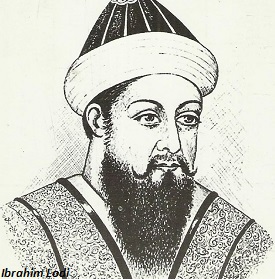
पानीपत की पहली लड़ाई में इब्राहिम लोदी 1526 में बाबर से हार गया था और अब से मुगल साम्राज्य की स्थापना हुई।
लोदी प्रशासन
लोदी राजाओं ने सल्तनत को मजबूत करने की कोशिश की और विद्रोही राज्यपाल की शक्ति पर अंकुश लगाने का प्रयास किया।
1489-1517 तक शासन करने वाले सिकंदर लोदी ने गंगा घाटी को पश्चिमी बंगाल तक नियंत्रित किया।
सिकंदर लोदी ने राजधानी को दिल्ली से आगरा स्थानांतरित कर दिया, क्योंकि उसे लगा कि वह अपने राज्य को ए ग्रा से बेहतर तरीके से नियंत्रित कर सकता है। उन्होंने लोक कल्याण के विभिन्न उपायों द्वारा लोगों की वफादारी को मजबूत करने का भी प्रयास किया।
रईसों
सल्तनत काल के दौरान, रईसों ने एक शक्तिशाली भूमिका निभाई। कभी-कभी, उन्होंने राज्य की नीति को भी प्रभावित किया और कभी-कभी (राज्यपाल के रूप में), उन्होंने विद्रोह किया और स्वतंत्र शासक बन गए या फिर दिल्ली के सिंहासन को हड़प लिया।
इनमें से कई रईस तुर्की या अफगानी थे, जो भारत में बस गए थे।
कुछ रईस पुरुष थे जो केवल अपने भाग्य की तलाश में भारत आए और सुल्तान के लिए काम किया।
अला-उद-दीन खिलजी के बाद, भारतीय मुसलमानों और हिंदुओं को भी अधिकारी (रईसों) के रूप में नियुक्त किया गया था।
सुल्तान ने भूमि के एक टुकड़े या एक गाँव से (महान) अधिकारी को वेतन देने के बजाय राजस्व देने की पुरानी प्रणाली का पालन किया।
Lodi Dynasty came after Sayyid dynasty and ruled until A.D. 1526.
Lodi Dynasty (1451–1526)
Lodi dynasty was originally from Afghan who ruled Delhi Sultanate for about 75 years.

Bahlul Lodi
Bahlul Lodi, who founded the dynasty and ruled Delhi from 1451 to 1489. After his death in 1489, his second son Sikandar Lodi succeeded the throne.
Sikandar Lodi
Sikandar Lodi took the title of Sikandar Shah. It was Sikandar Lodi who founded Agra city in 1504 and moved capital from Delhi to Agra.
Sikandar Lodi, further, abolished the corn duties and patronized trade and commerce in his kingdom.
Ibrahim Lodi
After Sikandar Lodi, Ibrahim Lodi (the youngest son of Sikandar Lodi) became sultan. Ibrahim Lodi was the last ruler of Lodi dynasty who ruled from 1517 to 1526.

Ibrahim Lodi was defeated by Babur in 1526, in the first battle of Panipat and from now Mughal Empire established.
Lodi Administration
The Lodi kings tried to consolidate the Sultanate and attempted to curb the power of rebellious governor.
Sikandar Lodi who ruled from 1489-1517, controlled the Ganges valley up to western Bengal.
Sikandar Lodi moved capital from Delhi to Agra, as he felt that he could control his kingdom better from A gra. He also tried to strengthen the loyalty of the people by various measures of public welfare.
The Nobles
During the sultanate period, the nobles played a powerful role. Sometimes, they even influenced state policy and sometimes (as governors), they revolted and became independent rulers or else usurped the throne of Delhi.
Many of these nobles were Turkish or Afghani, who had settled in India.
Some of the nobles were men who came to India only in search of their fortune and worked for the Sultan.
After Ala-ud-din Khilji, Indian Muslims and Hindus were also appointed as officers (nobles).
The Sultan followed the earlier system of granting the revenue from a piece of land or a village to the (noble) officer instead of paying them salary.
आईए जानते है लोदी राजवंश के बारे में || Let's know about the Lodi dynasty
तुगलक वंश खिलजी वंश के बाद आया और 1320 से 1413 ईस्वी तक शासन किया।
तुगलक वंश (1320-1413)
1,320 में, गाजी मलिक ग़ियाथ अल-दीन तुगलक की उपाधि के तहत राजा बना । इसी तरह, 'तुगलक' वंश शुरू हुआ।
मुहम्मद-बिन-तुगलकी
मुहम्मद-बिन-तुगलक (1325-51), सबसे बड़े पुत्र और गियाथ अल-दीन तुगलक के उत्तराधिकारी, तुगलक वंश के सबसे महत्वाकांक्षी और शक्तिशाली सुल्तानों में से एक थे।
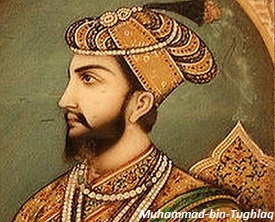
इब्न बतूता , उत्तरी अफ्रीकी अरब यात्री, मुहम्मद-बिन-तुगलक की अवधि के दौरान भारत आया था और उसने मुहम्मद के राज्य का विस्तृत विवरण लिखा था।
मुहम्मद आदर्शों के व्यक्ति थे जिन्होंने जहाँ तक संभव हो तर्क के सिद्धांतों पर शासन करने का प्रयास किया। वे एक महान ज्ञानी गणितज्ञ और तर्कशास्त्री थे।
मुहम्मद ने किसानों के करों में वृद्धि की (विशेषकर जो दोआब क्षेत्र से थे)। हालांकि, दोआब क्षेत्र में अकाल ने स्थिति को और खराब कर दिया।
अकाल के परिणामस्वरूप, लोगों ने अतिरिक्त करों का भुगतान करने से इनकार कर दिया और विद्रोह कर दिया; इसलिए, अंत में, सुल्तान को अपना आदेश रद्द करना पड़ा।
मुहम्मद ने राजधानी को दिल्ली से देवगिरी (जिसका नाम उन्होंने दौलताबाद रखा) में स्थानांतरित कर दिया। उनकी रणनीतिक योजना के अनुसार, दौलताबाद (महाराष्ट्र में आधुनिक औरंगाबाद के पास स्थित) दक्कन को नियंत्रित करने के लिए एक बेहतर जगह थी।
हालाँकि, राजधानी का स्थानांतरण सफल नहीं रहा, क्योंकि यह उत्तरी भारत से बहुत दूर थी, और इसलिए, सुल्तान उत्तरी सीमाओं पर नजर नहीं रख सकता था। इसलिए, मुहम्मद ने राजधानी को वापस दिल्ली लौटा दिया।
मुहम्मद ने पीतल और तांबे पर 'टोकन' सिक्के जारी करने का फैसला किया, जिसे खजाने से चांदी के सिक्कों के लिए बदला जा सकता था। यह योजना काम करती, अगर वह इसकी सावधानीपूर्वक निगरानी करता और केवल सरकारी निकाय को टोकन सिक्के जारी करने की अनुमति देता। लेकिन ऐसा नहीं हुआ बल्कि कई लोगों ने पीतल और तांबे के 'टोकन' बनाना शुरू कर दिया और इसलिए सुल्तान का वित्त पर कोई नियंत्रण नहीं था। टोकन सिक्कों को वापस लेना पड़ा।
दुर्भाग्य से, मुहम्मद की कई प्रशासनिक नीतियां विफल रहीं; इसलिए, धीरे-धीरे उसने न केवल लोगों का, बल्कि कई रईसों और उलेमाओं का भी समर्थन खो दिया ।
उलेमा इस्लामी शिक्षा के विद्वान थे जो आमतौर पर अपने दृष्टिकोण में रूढ़िवादी थे।
फिरोज शाह तुगलक
मार्च, 1351 में, मुहम्मद की मृत्यु हो गई। उनकी मृत्यु के बाद, उनके चचेरे भाई फिरोज शाह गद्दी पर बैठे जिन्होंने 1388 तक शासन किया।

फ़िरोज़ ने महसूस किया कि मुहम्मद की विफलता का एक कारण यह था कि उसे रईसों का समर्थन नहीं था। इसलिए फिरोज ने पहले उनके साथ मैत्रीपूर्ण संबंध स्थापित किए और उन्हें अनुदान या राजस्व देकर खुश किया।
फ़िरोज़ ने आगे, रूढ़िवादी उलेमा को कुछ मामलों में राज्य की नीति को प्रभावित करने की अनुमति दी। इस प्रकार फिरोज ने दरबार में शक्तिशाली समूहों के साथ अपने संबंधों में सुधार किया; हालाँकि, इन सब के बावजूद, सुल्तान की शक्ति में कमी आई।
इस बीच, बिहार और बंगाल सहित कुछ प्रांतों के राज्यपालों ने सल्तनत के खिलाफ विद्रोह कर दिया था। फिरोज ने उन्हें नियंत्रित करने की कोशिश की, लेकिन बहुत सफल नहीं हुए।
फिरोज अपनी प्रजा के सामान्य कल्याण में सुधार करने में रुचि रखते थे। उन्होंने नई सिंचाई योजनाएँ शुरू करके राज्य के कुछ हिस्सों में सुधार किया। यमुना नहर उनकी योजनाओं में से एक थी।
फ़िरोज़ ने कुछ नए शहर भी स्थापित किए, जैसे फ़िरोज़पुर, फ़िरोज़ाबाद, हिसार-फ़िरोज़ा और जौनपुर।
फिरोज ने कई शिक्षण केन्द्रों और अस्पतालों का भी निर्माण किया। वह भारत की प्राचीन संस्कृति में रुचि रखते थे। फिरोज ने कई संस्कृत पुस्तकों का फारसी और अरबी भाषाओं में अनुवाद करने का आदेश दिया।
फिरोज के पास सम्राट अशोक के दो स्तंभ भी थे और उनमें से एक उनके महल की छत पर रखा गया था।
सितंबर 1388 में फिरोज की मृत्यु हो गई, जिसके बाद उनके वंशजों के बीच गृहयुद्ध छिड़ गया। राजनीतिक अस्थिरता के कारण, कई प्रांतों के राज्यपाल स्वतंत्र राजा बन गए और अंत में दिल्ली के आसपास का एक छोटा सा क्षेत्र तुगलक सुल्तानों के हाथों में रह गया।
सैय्यद वंश (1413 - 1451)
1413 तक, तुगलक वंश पूरी तरह से समाप्त हो गया और स्थानीय गवर्नर ने दिल्ली पर कब्जा कर लिया और सैय्यद राजवंश को रास्ता दे दिया ।
1398 में, तुर्की प्रमुख तैमूर ने भारत पर आक्रमण किया और भारतीय धन को लूट लिया। वापस लौटते समय, उन्होंने खिज्र खान को दिल्ली का राज्यपाल नियुक्त किया।
खिज्र खान ने दिल्ली को दौलत खान लोदी से ले लिया था और 1414 में सैय्यद वंश की स्थापना की थी। सैय्यद वंश ने 1451 तक दिल्ली पर शासन किया था।
1421 में, खिज्र खान की मृत्यु हो गई, इसलिए, उसका पुत्र मुबारक खान सफल हुआ। मुबारक खान ने अपने सिक्कों पर खुद को 'मुइज़-उद-दीन मुबारक शाह' के रूप में दर्शाया।
मुबारक खान ने 1434 तक शासन किया और उसके बाद उसके भतीजे मुहम्मद शाह ने शासन किया। मुहम्मद शाह ने 1445 तक शासन किया।
मुहम्मद अला-उद-दीन आलम शाम द्वारा सफल हुए, जिन्होंने 1451 तक शासन किया। 1451 में, बहलुल लोदी सुल्तान बने और लोदी वंश की स्थापना की
Tughlaq dynasty came after the Khilji dynasty and ruled from A.D. 1320 to 1413.
Tughlaq Dynasty (1320 – 1413)
In 1,320, Ghazi Malik became the king under the title of Ghiyath al-Din Tughlaq. Likewise, the ‘Tughlaq’ dynasty began.
Muhammad-bin-Tughlaq
Muhammad-bin-Tughlaq (1325-51), the eldest son and successor of Ghiyath al-Din Tughlaq, was one of the most ambitious and powerful Sultans of Tughlaq dynasty.

Ibn Battutah, the North African Arab traveler, came India during Muhammad-bin-Tughlaq’s period and he had written the detailed description of the Muhammad’s kingdom.
Muhammad was a man of ideals who attempted as far as possible, to rule on the principles of reason. He was a great knowledgeable mathematician and a logician.
Muhammad increased the taxes of the peasants (especially who were from the Doab area). However, a famine in the Doab region made condition worse.
As a result of famine, the people refused to pay the extra taxes and rose in rebellion; therefore, finally, the Sultan had to cancel his order.
Muhammad also moved the capital from Delhi to Devagiri (which he renamed Daulatabad). As per his strategic plan, Daulatabad (located nearby modern Aurangabad in Maharashtra) was a better place for controlling the Deccan.
The moving of the capital was, however, not successful, as it was too far from northern India, and hence, the Sultan could not keep a watch on the northern frontiers. Therefore, Muhammad returned the capital back to Delhi.
Muhammad decided to issue 'token' coins on brass and copper, which could be exchanged for silver coins from the treasury. This scheme would have worked, if he had monitored it carefully and allowed strictly only to the government body to issue token coins. But it did not happen rather many people started making brass and copper ‘tokens’ and the Sultan, therefore, had no control over the finances. The token coins had to be withdrawn.
Unfortunately, Muhammad’s many administrative policies failed; hence, gradually he lost the support not only of the people, but also many of the nobles and the ulema.
The ulema were the scholars of Islamic learning who were generally orthodox in their outlook.
Firoz Shah Tughlaq
In March, 1351, Muhammad died. After his death, his cousin Firoz Shah came to the throne who ruled till 1388.

Firoz realized that one of the reasons for the failure of Muhammad was that he did not have the support of the nobles. Therefore, Firoz first established a friendly relation with them and made them happy by giving them, grants or revenue.
Firoz, further, allowed the orthodox ulema to influence state policy in certain matters. Thus Firoz improved his relationship with the powerful groups at the court; however, in spite of all these, the power of the Sultan decreased.
In the meantime, the governors of certain provinces, including Bihar and Bengal, had rebelled against the Sultanate. Firoz tried to control them, but was not very successful.
Firoz was interested in improving the general welfare of his subjects. He improved parts of the kingdom by starting new irrigation schemes. The Yamuna Canal was one of his schemes.
Firoz also established a few new towns, such as Ferozpur, Ferozabad, Hissar-Firoza, and Jaunpur.
Firoz also constructed many educational centers and hospitals. He was interested in the ancient culture of India. Firoz order to translate a number of Sanskrit books into Persian and Arabic languages.
Firoz also owned two of the pillars of the emperor Ashoka and one of them was placed on the roof of his palace.
In September 1388, Firoz died, after which there was a civil war among his descendants. Because of the political instability, the governors of many provinces became independent kings and finally only a small area around Delhi remained in the hands of the Tughluq Sultans.
Sayyid Dynasty (1413 – 1451)
By 1413, the Tughlaq dynasty ended completely and local governor occupied Delhi and given way to Sayyid Dynasty.
In 1398, Timur, the Turkish chief invaded India and robbed Indian wealth. While returning back, he appointed Khizr Khan as the governor of Delhi.
Khizr Khan had taken Delhi from Daulat Khan Lodi and founded Sayyid dynasty in 1414. Sayyid dynasty ruled Delhi until 1451.
In 1421, Khizr Khan died, hence, his son Mubarrak Khan succeeded. Mubarrak Khan represented himself as ‘Muizz-ud-Din Mubarak Shah’ on his coins.
Mubarrak Khan ruled till 1434 and he was succeeded by his nephew Muhammad Shah. Muhammad Shah ruled till 1445.
Muhammad succeeded by Ala-ud-din Alam Sham, who ruled till 1451. In 1451, Bahlul Lodi became the Sultan and founded the Lodi dynasty.
तुगलक वंश के बारे में सारी जानकारियां || All information about Tughlaq dynasty
खिलजी वंश मामलुकों के बाद आया और 1320 ईस्वी तक शासन किया।
खिलजी वंश (1290 - 1320)
1,290 में, गुलाम सुल्तानों के बाद एक नया राजवंश आया, जिसे खिलजी के नाम से जाना जाता है। खिलजी वंश का संस्थापक जलाल उद दीन फिरोज खिलजी था।
अलाउद्दीन खिलजी , जो जलाल-उद-दीन का भतीजा और दामाद था, खिलजी वंश के सबसे महत्वाकांक्षी और शक्तिशाली सुल्तानों में से एक था। वह दुनिया को जीतना चाहता था (दूसरा सिकंदर बनने के लिए)।
सुल्तान बनने पर अलाउद्दीन खिलजी ने नागरिकों को उपहार (सोने के) दिए। साथ ही, उसने यह भी तर्क दिया कि वह एक मजबूत और शक्तिशाली शासक था और इसलिए, वह किसी भी व्यक्ति के साथ सख्ती से पेश आएगा जो विश्वासघात के लक्षण दिखाएगा।
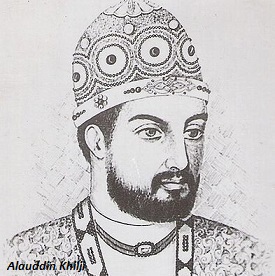
अलाउद्दीन खिलजी ने दोआब (गंगा और यमुना नदियों के बीच उपजाऊ क्षेत्र) के धनी लोगों पर भूमि कर बढ़ा दिया। इसके अलावा, वह राजस्व की कड़ाई से निगरानी करता था, जो रईसों को उनकी भूमि से मिलता था और इसलिए, उन्हें कुछ भी रखने की अनुमति नहीं थी, जो उनका देय नहीं था।
वस्तुओं की कीमतों को भी बारीकी से नियंत्रित किया जाता था ताकि हर कोई मांग की गई कीमत का भुगतान कर सके और साथ ही कोई भी बड़ा लाभ नहीं कमा सके।
अलाउद्दीन खिलजी ने एक नई नीति बनाई यानी उसने खेती की जमीन और राजस्व के नए मूल्यांकन का आदेश दिया। सबसे पहले, खेती के अधीन भूमि (उसके राज्य की) को मापा गया। और इन जमीनों के राजस्व का आकलन माप के आधार पर किया जाता था।
अलाउद्दीन खिलजी ने गुजरात और मालवा के राज्यों के खिलाफ अभियान चलाया। उसने रणथंभौर और चित्तौड़ के प्रसिद्ध किलों पर कब्जा करके राजस्थान पर अपना नियंत्रण स्थापित करने का प्रयास किया।
मलिक काफूर के आदेश के तहत, अला-उद-दीन ने प्रायद्वीप को जीतने के साथ-साथ धन और धन प्राप्त करने के इरादे से दक्षिण की ओर एक बड़ी सेना भेजी।
मलिक काफूर ने सभी दिशाओं में लूटपाट की और दक्षिण के विभिन्न राज्यों से बड़ी मात्रा में सोना एकत्र किया, जिसमें यादव (देवगिरी के), काकतीय (वारंगल के) और होयसाल ( द्वारसमुद्र के) शामिल थे।
पराजित शासकों को अपना सिंहासन रखने की अनुमति दी गई थी, बशर्ते वे श्रद्धांजलि अर्पित करें। मलिक काफूर ने मदुरै शहर को भी जीत लिया। उस समय तक किसी भी उत्तर भारतीय शासक ने दक्षिण भारत में अब तक घुसने का प्रयास नहीं किया था।
1,315 में अलादीन खिलजी की मृत्यु हो गई। उनकी मृत्यु के बाद, उत्तराधिकार के लिए एक अराजक स्थिति थी। महत्वाकांक्षी मलिक काफूर ने खुद को सुल्तान बना लिया, लेकिन उसे मुस्लिम अमीरों का समर्थन नहीं मिला और इसलिए, कुछ महीनों के बाद ही उसे मार दिया गया।
1,320 तक, तीन और खिलजी उत्तराधिकारियों ने सत्ता संभाली, लेकिन कोई भी कायम नहीं रहा बल्कि बेरहमी से मारा गया। इसी तरह, तुगलक नामक एक नए राजवंश की स्थापना हुई।
Khilji dynasty came after Mamluks and ruled until A. D. 1320.
Khilji Dynasty (1290 – 1320)
In 1,290, the Slave Sultans were succeeded by a new dynasty, known as Khiljis. Jalal ud din Firuz Khilji was the founder of Khilji dynasty.
Alauddin Khilji, who was the nephew and son-in-law of Jalal-ud-din was one of the most ambitious and powerful sultans of Khilji dynasty. He wanted to conquer the world (to become second Alexander).
Alauddin Khilji, when became sultan, gave presents (of gold) to the citizens. At the same time, he also contended that he was a strong and powerful ruler and hence, he would deal severely with anyone who showed signs of disloyalty.

Alauddin Khilji raised the land taxes on the wealthier people of the Doab (the fertile area between the Ganga and Yamuna rivers). Further, he strictly monitored the revenue, which the nobles got from their land and hence, did not allow them to keep anything, which was not their due.
The prices of goods were also closely controlled so that everyone could afford to pay the price demanded as well as no one could make a large profit.
Alauddin Khilji made a new policy i.e. he ordered a new assessment of the cultivated land and the revenue. First, the land under cultivation (of his kingdom) was measured. And the revenue of these lands was assessed on the basis of the measurement.
Alauddin Khilji campaigned against the kingdoms of Gujarat and Malwa. He tried to establish his control over Rajasthan by capturing the famous forts of Ranthambhor and Chittor.
Under the command of Malik Kafur, Ala-ud-din sent a large army towards the south with the intention to conquer the peninsula as well as obtain money and wealth.
Malik Kafur plundered in all directions and collected a large amount of gold from the various kingdoms of the south, including the Yadavas (of Devagiri), the Kakatiyas (of Warangal), and the Hoyasalas (of Dvarasamudra).
The defeated rulers were allowed to keep their throne provided they paid a tribute. Malik Kafur also conquered the city of Madurai. By the time, no north Indian ruler attempted to penetrate so far in the south India.
In 1,315, Aladdin Khilji died. After his death, there was a chaotic situation for the succession. Ambitious Malik Kafur made himself as sultan, but lacked support from Muslim amirs and hence, he was killed only after few months.
By 1,320, three more Khilji successors assumed power, but no one sustained rather killed brutally. Likewise, a new dynasty namely Tughlaq was founded.
जानिए खिलजी राजवंश कब आया था भारत में || Know when the Khilji dynasty came to India
मुहम्मद गोरी की मृत्यु के बाद, गुलाम सुल्तानों ने भारत पर शासन किया।
गुलाम सुल्तान (ई. 1206-1290)
मामलुक्स दिल्ली सल्तनत के शुरुआती शासक थे। उन्हें गुलाम राजाओं के रूप में भी जाना जाता है क्योंकि उनमें से कई या तो गुलाम थे या गुलामों के बेटे थे और सुल्तान बन गए।
गुलाम राजाओं में से पहला कुतुब-उद-दीन ऐबक था, जो मुहम्मद गोरी का सेनापति था। गोरी की मृत्यु के बाद, कुतुब-उद-दीन भारत में रहा और उसने अपना राज्य स्थापित किया।
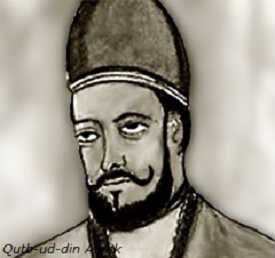
गजनी के शासक ने कुतुब-उद-दीन के कब्जे वाले क्षेत्र पर कब्जा करने की कोशिश की, लेकिन वह असफल रहा। जब इल्तुतमिश कुतुब-दीन के सुल्तान के रूप में उत्तराधिकारी बना, तो उत्तरी भारत में एक अलग राज्य की स्थापना हुई, जिसका नाम दिल्ली सल्तनत था । ।
समय के साथ, दिल्ली के सुल्तानों ने पूर्व में बंगाल और पश्चिम में सिंध तक अपना नियंत्रण बढ़ाया।
सल्तनत काल के दौरान, स्थानीय भारतीय शासकों की समस्या थी जिन पर विजय प्राप्त की गई थी। सुल्तानों ने कुछ शासकों के क्षेत्र ले लिए थे और कुछ अन्य को इसे रखने की अनुमति थी।
जिन शासकों को अपने क्षेत्र रखने की अनुमति दी गई थी, उन्होंने एक श्रद्धांजलि के रूप में धन का भुगतान किया और आवश्यकता पड़ने पर सैन्य सहायता के साथ सुल्तान की मदद करने के लिए सहमत हुए।
सल्तनत को उत्तर-पश्चिम से भी समस्याएँ थीं, उदाहरण के लिए, अफगानिस्तान के शासक शांत थे, लेकिन चंगेज खान के नेतृत्व में मध्य एशिया के मंगोल लोगों ने नई विजय प्राप्त की।
सुल्तान इल्तुतमिश को प्रशासनिक समस्याओं का सामना करना पड़ा था। हालाँकि, जब उनकी मृत्यु हुई, तो उनकी बेटी रजिया सुल्तान बनी और उन्हें समस्याओं का सामना करना पड़ा।
इल्तुतमिश के बाद अगला महत्वपूर्ण सुल्तान बलबन था था , जो एक मजबूत और लौह-इच्छा वाला सुल्तान था। वह अपने पूर्ववर्तियों की तुलना में समस्याओं को हल करने में अधिक सफल रहे। उसने मंगोलों के हमलों से सल्तनत की रक्षा की।
बलबन ने उसे परेशान करने वाले स्थानीय शासकों के खिलाफ लड़ाई लड़ी। उनकी सबसे बड़ी समस्या रईसों की थी जो बहुत शक्तिशाली हो गए थे और सुल्तान की स्थिति को खतरे में डाल रहे थे। धीरे-धीरे लेकिन दृढ़ता से, बलबन ने उनकी शक्ति को तोड़ दिया और अंत में सुल्तान की स्थिति सबसे महत्वपूर्ण हो गई।
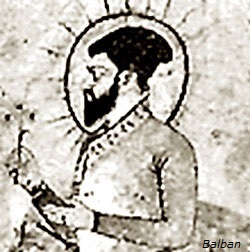
बलबन की सफलता को उसकी सामरिक प्रशासनिक नीति में एकीकृत कर दिया गया। उसने सेना के संगठन को सफलतापूर्वक बदल दिया और रईसों के विद्रोह को दबा दिया।
बलबन ने लोगों को उनकी उपस्थिति में ' सिजदा ' करने के लिए प्रोत्साहित किया। सिजदा का अर्थ है, लोगों को उन्हें (बलबन) को प्रणाम करने के लिए घुटने टेककर अपने माथे से जमीन को छूना पड़ा।
सिजदा ने रूढ़िवादी मुसलमानों को भयभीत कर दिया। मुसलमानों की मान्यता के अनुसार, "सभी पुरुष समान हैं, और इसलिए, भगवान के अलावा किसी और के सामने किसी को भी सिजदा नहीं करना चाहिए ।"
After Muhammad Ghori’s death, slave sultans were ruled India.
The Slave Sultans (AD. 1206-1290)
Mamluks were the earliest rulers of the Delhi Sultanate. They are also known as the Slave Kings because many of them were either slaves or were the sons of slaves and became Sultans.
The first of the slave kings was Qutb-ud-din Aibak, who was the general of Muhammad Ghori. After the death of Ghori, Qutb-ud-din stayed in India and established his kingdom.

The ruler of Ghazni tried to annex the territory held by Qutb-ud-din, but he failed. When lltutmish succeeded Qutbud-din as Sultan, a separate kingdom was established in the northern India, namely Delhi Sultanate.
Over a period of time, the Sultans of Delhi extended their control up to Bengal in the east and Sind in the west.
During the Sultanate period, there was the problem of the local Indian rulers who had been conquered. Sultans had taken territories of some rulers and some others were allowed to keep it.
The rulers who were allowed to keep their territories paid a sum of money as a tribute and agreed to help the Sultan with military support when required.
Sultanate had also problems from the north-west, for example, the rulers of Afghanistan were quiet, but the Mongol people of Central Asia, led by Chenghiz Khan, made fresh conquests.
The Sultan Iltutmish had faced the administrative problems. However, when he died, his daughter Raziya became the sultan and she had to face the problems.
After Iltutmish, the next important Sultans was Balban, a strong and iron-willed Sultan. He was more successful in solving the problems than his predecessors. He defended the Sultanate from the attacks of the Mongols.
Balban fought against the local rulers who troubled him. His biggest problem was the nobles who had become very powerful and were threatening the position of the Sultan. Slowly but firmly, Balban broke their power and finally the position of the Sultan became all-important.

Balban’s success was integrated into his strategic administrative policy. He successfully changed the organization of the army and curbed the revolt of the nobles.
Balban encouraged people to do the ‘sijdah’ in his presence. Sijdah means, people had to kneel and touch the ground with their forehead in salutation to him (Balban).
Sijdah, horrified the orthodox Muslims. According to Muslims belief, “all men are equal, and therefore, no one should do the sijdah before anyone else except God.”
क्या आप दिल्ली की सल्तनत के बारे में जानते है || Do you know about Delhi Sultanate?
गजनी के महमूद और मुहम्मद गोरी, ये दोनों प्रारंभिक मध्ययुगीन काल के प्रमुख आक्रमणकारी थे।
गजनी के महमूद
गजनी अफगानिस्तान में एक छोटा सा राज्य था, जिसकी स्थापना दसवीं शताब्दी में एक तुर्की रईस ने की थी। इसके उत्तराधिकारी महमूद गजनी को एक बड़ा और शक्तिशाली राज्य बनाना चाहते थे; इसलिए, उसने मध्य एशिया के एक हिस्से को जीतने का फैसला किया।
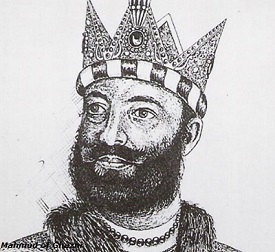
महमूद को अपनी विशाल और शक्तिशाली सेना बनाने के लिए एक विशाल संपत्ति की आवश्यकता थी; इसलिए, उन्होंने भारतीय धन को लूटने के लिए (अपनी महान महत्वाकांक्षा को पूरा करने के लिए) भारत पर हमला करने का फैसला किया।
महमूद का पहला आक्रमण 1,000 ईस्वी सन् में शुरू हुआ। महमूद ने पच्चीस वर्षों की छोटी अवधि में सत्रह छापे मारे। इस बीच, उन्होंने मध्य एशिया और अफगानिस्तान में भी लड़ाई लड़ी।
1010 और 1025 ईस्वी के बीच महमूद ने केवल उत्तरी भारत के मंदिरों के नगरों पर हमला किया, क्योंकि उसने सुना था कि भारत में बड़े मंदिरों में बहुत सारे सोने और गहने रखे गए थे।
इन हमलों में से एक, जिसका अक्सर मध्यकालीन इतिहास पर चर्चा करते समय उल्लेख किया जाता है, पश्चिमी भारत में स्थित सोमनाथ मंदिर का विनाश था।
1,030 में, महमूद की मृत्यु हो गई और उत्तर भारत के लोगों को राहत मिली। हालांकि महमूद भारतीयों के लिए विध्वंसक था, लेकिन अपने ही देश में, वह एक सुंदर मस्जिद और एक बड़े पुस्तकालय का निर्माता था।
महमूद प्रसिद्ध फारसी कवि, फिरदौसी के संरक्षक थे, जिन्होंने महाकाव्य ' शाह नमः ' लिखा था ' लिखा था ।
महमूद ने मध्य एशियाई विद्वान अलबरूनी को भारत भेजा, जो यहां कई वर्षों तक रहे और उन्होंने देश और लोगों की स्थिति का वर्णन करते हुए अपना अनुभव लिखा था।
मुहम्मद गौरी
मुहम्मद गोरी अफगानिस्तान के एक छोटे से राज्य घोर साम्राज्य का शासक था। वह घुरिद साम्राज्य का सर्वोच्च शासक था।
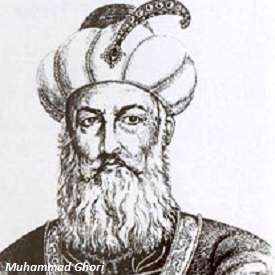
गोरी महमूद की तुलना में अधिक महत्वाकांक्षी था, क्योंकि वह न केवल भारत की संपत्ति को लूटने में रुचि रखता था, बल्कि उत्तरी भारत को जीतकर उसे अपने राज्य में जोड़ने का भी इरादा रखता था।
चूंकि पंजाब पहले से ही गजनी साम्राज्य का हिस्सा था; इसलिए, गोरी के लिए भारत अभियान की योजना बनाना आसान हो गया।
भारत में मुहम्मद का सबसे महत्वपूर्ण अभियान चौहान शासक पृथ्वीराज III के खिलाफ था। 1191 में, पृथ्वीराज ने गोरी को हराया; इस लड़ाई को लोकप्रिय रूप से ' तराइन की पहली लड़ाई ' के रूप में जाना जाता है ।
1192 में, मुहम्मद गोरी ने तारिन की दूसरी लड़ाई में पृथ्वीराज को हराया। पृथ्वीराज की हार ने मुहम्मद के लिए दिल्ली क्षेत्र खोल दिया और वह अपनी शक्ति स्थापित करने लगा।
1206 में, गोरी की हत्या कर दी गई और उत्तरी भारत में उसका राज्य उसके सेनापति कुतुब-उद-दीन ऐबक के नियंत्रण में छोड़ दिया गया ।
Mahmud of Ghazni and Muhammad Ghori, these two were the major invaders of the early medieval period.
Mahmud of Ghazni
Ghazni was a small kingdom in Afghanistan, which was founded by a Turkish nobleman in the tenth century. One of its successors, namely Mahmud wanted to make Ghazni into a big and powerful kingdom; therefore, he decided to conquer a part of Central Asia.

In order to make his large and powerful army, Mahmud had needed a huge property; hence, he decided to attack India to rob Indian wealth (to accomplish his great ambition).
The first raid of Mahmud began in A.D. 1,000. In a short period of twenty-five years, Mahmud made seventeen raids. Meanwhile, he fought battles in Central Asia and in Afghanistan as well.
Between A.D. 1,010 and 1025, Mahmud attacked only on the temple towns in northern India, as he had heard that there were much gold and jewelry kept in the big temples in India.
One of these attacks, which is frequently mentioned while discussing Medieval History, was the destruction of the Somnath temple located in western India.
In 1,030, Mahmud died and the people of northern India get relieved. Though Mahmud was destructor for the Indians, but in his own country, he was a builder of a beautiful mosque and a large library.
Mahmud was the patron of the famous Persian poet, Firdausi, who wrote the epic poem ‘Shah Namah.’
Mahmud sent the Central Asian scholar Alberuni to India, who lived here for many years and had written his experience, describing the country and the condition of the people.
Muhammad Ghori
Muhammad Ghori was the ruler of the Ghor kingdom, a small kingdom of Afghanistan. He was the supreme ruler of Ghurid Empire.

Ghori was more ambitious than Mahmud, as he was not only interested in robbing wealth of India, but also intended in conquering northern India and adding it to his kingdom.
Since Punjab had already been a part of the Ghazni kingdom; therefore, it made easier to Ghori to plan India campaign.
Muhammad's most important campaign in India was against the Chauhan ruler, Prithviraj III. In 1191, Prithviraj defeated Ghori; this battle is popularly known as the ‘first battle of Tarain.’
In 1192, Muhammad Ghori defeated Prithviraj in the second battle of Tarin. The defeat of Prithviraj opened the Delhi area to Muhammad and he began to establish his power.
In 1206, Ghori was murdered and his kingdom in northern India was left in the control of his general Qutb-ud-din Aibak.
मध्ययुगीन काल के प्रमुख आक्रमणकारी || Major Invaders of the Medieval Period
राजपूत हमेशा इस बात पर जोर देते थे कि वे क्षत्रिय जाति के हैं और वे कुलों में बंटे हुए हैं।
राजपूत राजा आदेशित परिवार के थे, जो उन्हें प्राचीन भारतीय राजाओं के सूर्य-परिवार ( सूर्य- वंशी ) या चंद्र-परिवार ( चंद्र-वंश ) से जोड़ता था। हालांकि, चार कुलों ने दावा किया कि वे इन दोनों परिवारों में से किसी एक से नहीं, बल्कि अग्नि-परिवार ( अग्नि-कुल ) के वंशज थे।
राजपूत वंश
चार कुलों, अर्थात् -
प्रतिहार, (या परिहार),
चौहान (या चाहमान),
सोलंकी (या चालुक्य), और
पवार (या परमार)।
इन चार अग्निकुल कुलों ने पश्चिमी भारत और मध्य भारत के कुछ हिस्सों में अपनी शक्ति स्थापित की।
परिहारों ने कन्नौज के क्षेत्र में शासन किया;
मध्य राजस्थान में चौहान मजबूत थे;
काठियावाड़ और आसपास के क्षेत्रों में सोलंकी शक्ति बढ़ी, और
पवारों ने इंदौर के निकट धार में अपनी राजधानी के साथ मालवा के क्षेत्र में खुद को स्थापित किया।
इसके अलावा, कुछ अन्य छोटे शासक भी शक्तिशाली हो गए और धीरे-धीरे उत्तर भारत के विभिन्न हिस्सों में छोटे राज्यों का निर्माण किया, उदाहरण के लिए -
नेपाल,
कामरूपा (असम में),
कश्मीर, और
उत्कल (उड़ीसा में)।
पंजाब के कई पहाड़ी राज्य भी मध्ययुगीन काल के प्रारंभिक चरण के दौरान विकसित हुए; जैसे -
चंपा (चंबा),
दुर्गारा (जम्मू), और
हिमाचल में कुलुता (कुल्लू)।
मध्य भारत के कुछ अन्य उल्लेखनीय राज्य (राजपूतों के समकालीन) थे -
बुंदेलखंड में चंदेल,
चौहानों के दक्षिण में मेवाड़ में गुहिल, तथा
हरियाणा और दिल्ली क्षेत्र में तोमर।
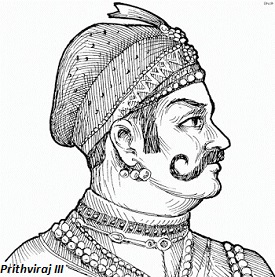
समय के साथ, चौहानों ने तोमरों को हराया और उनके राज्य पर कब्जा कर लिया।
चौहान वंश के राजकुमार पृथ्वीराज III , उत्तरी भारत में उस काल के सबसे शक्तिशाली राजा थे। उनके (पृथ्वीराज के) दरबार के हिन्दी कवि चंदबरदाई ने प्रसिद्ध कविता ' पृथ्वीराज-रासो ' लिखी थी ।
The Rajputs always insisted that they were of the kshatriya caste and they were divided into clans.
The Rajput kings belonged to ordered family, which connected them with either the sun-family (surya-vamshi) or the moon-family (chandra-vamsha) of ancient Indian kings. However, there were four clans who claimed that they had not descended from either of these two families, but rather from the fire-family (agni-kula).
Rajput Clans
The four clans, namely −
Pratiharas, (or Pariharas),
Chauhans (or Chahamanas),
Solankis (or Chaulukyas), and
Pawars (or Paramaras).
These four agni-kula clans established their power in western India and parts of central India.
The Pariharas ruled in the region of Kanauj;
The Chauhans were strong in central Rajasthan;
Solanki power rose in the region of Kathiawar and the surrounding areas, and
The Pawars established themselves in the region of Malwa with their capital at Dhar near Indore.
Besides, some other minor rulers also became powerful and gradually built small kingdoms in various parts of northern India, for example −
Nepal,
Kamarupa (in Assam),
Kashmir, and
Utkala (in Orissa).
Many of the hill states of the Punjab also developed during the early phase of medieval period; such as −
Champaka (Chamba),
Durgara (Jammu), and
Kuluta (Kulu) in Himachal.
Some other worth noting kingdoms of central India (contemporary to the Rajputs) were −
The Chandelles in Bundelkhand,
The Guhilas in Mewar to the south of the Chauhans, and
The Tomaras in Haryana and the Delhi region.

Over a period of time, the Chauhans defeated the Tomaras and annexed their kingdom.
Prithviraj III, the prince of Chauhan dynasty, was the most powerful king of that period in northern India. Chandbardai, the Hindi poet of his (Prithviraj’s) court had written the famous poem ‘Prithviraja-raso.’
राजपूत वंश जो क्षत्रिय थे सारी जानकारियां || Rajput dynasty who were Kshatriya all information
उत्तर भारत में, गुप्तोत्तर युग में बड़े पैमाने पर विभिन्न छोटे राज्यों का युग शामिल था। हालाँकि, इन छोटे राज्यों में, तीन बड़े राज्य थे (750 और 1,000 ईस्वी के बीच), अर्थात् -
राष्ट्रकूट,
प्रतिहार, और
पलास
ये सभी राज्य बार-बार आपस में लड़ते रहे और उत्तरी भारत पर अधिकार करने का प्रयास किया; हालांकि, उनमें से कोई भी लंबे समय तक सफल नहीं हुआ।
कन्नौज के लिए संघर्ष
कन्नौज हर्ष की राजधानी थी और एक महत्वपूर्ण शहर था; इसलिए, उत्तर भारत में कई अभियान कन्नौज शहर पर लड़े गए थे।
कन्नौज भौगोलिक रूप से उत्तरी मैदान में स्थित था; एक रणनीतिक बिंदु जहां से गंगा घाटी को नियंत्रित करना आसान था।
कन्नौज को नियंत्रित करने के इस संघर्ष में तीन प्रमुख राज्य शामिल थे; आधुनिक इतिहासकार उन्हें 'कनौज के लिए त्रिपक्षीय (अर्थात तीन दल) संघर्ष' कहना पसंद करते हैं। तीन राज्य राष्ट्रकूट , प्रतिहार और पाल थे ।
राष्ट्रकूट साम्राज्य
राष्ट्रकूटों का राज्य उत्तरी दक्कन यानी नासिक के आसपास के क्षेत्र में स्थित था और इसकी राजधानी मलखेड में थी (जैसा कि नीचे दी गई छवि में दिखाया गया है)। मलखेड न केवल एक सुंदर, बल्कि एक समृद्ध शहर भी था।

अमोघवर्ष (800 से 878 ई.), न केवल एक महत्वाकांक्षी था, बल्कि राष्ट्रकूट साम्राज्य का एक महान सम्राट भी था।
प्रतिहार साम्राज्य
अरबों के साथ अपनी सफलता के बाद, प्रतिहारों ने अपनी सेनाओं को पूर्व की ओर ले लिया और आठवीं शताब्दी के अंत तक कन्नौज पर कब्जा कर लिया था।
पाल साम्राज्य
पाल, जिन्होंने लगभग चार सौ वर्षों तक शासन किया और उनके राज्य में लगभग पूरा बंगाल और बिहार का अधिकांश भाग शामिल था, कन्नौज को नियंत्रित करने के लिए भी इच्छुक थे।
पाल वंश का पहला राजा गोपाल था । पिछले शासक की मृत्यु (बिना उत्तराधिकारी के मृत्यु) के बाद उन्हें रईसों द्वारा राजा के रूप में चुना गया था। इसलिए गोपाल पाल वंश का संस्थापक था।
गोपाल के पुत्र और उत्तराधिकारी धर्मपाल ने हालांकि राजवंश को और अधिक शक्तिशाली बनाने का प्रयास किया, लेकिन अपने शासनकाल के प्रारंभिक चरण के दौरान, वह राष्ट्रकूट राजा से हार गया।
धर्मपाल ने बाद में अपनी शक्ति को आंशिक रूप से एक मजबूत सेना बनाकर और आंशिक रूप से पड़ोसी राज्यों के साथ गठबंधन करके और खुद को कन्नौज पर हमला करने के लिए तैयार किया।
पाल लोग कन्नौज को अधिक समय तक अपने पास नहीं रख सके। राजा भोज के शासनकाल के दौरान प्रतिहारों ने अपनी ताकत वापस पा ली। भोज ने लगभग 836 से 882 ईस्वी तक शासन किया और उत्तरी भारत का सबसे प्रतिष्ठित राजा था।
भोज ने प्रतिहारों के लिए कन्नौज पर पुनः अधिकार कर लिया। लेकिन बाद में वह शक्तिशाली राष्ट्रकूट राजा, ध्रुव से हार गया।
सुलेमान, एक अरब व्यापारी ने लिखा था कि ' जुजर ' एक समृद्ध राज्य पर शासन करने वाला एक शक्तिशाली राजा था।
कई इतिहासकारों का मानना है कि 'जुजर' शायद गुजरात को दिया गया अरबी नाम और सुलेमान द्वारा वर्णित राजा शायद भोज था। भोज को साहित्य में उनकी रुचि और वैष्णववाद के संरक्षण के लिए भी याद किया जाता है ।
भोज द्वारा पेश किए गए उनके कुछ सिक्कों में वराह (सूअर) का चित्र है - विष्णु का एक अवतार। इसके अलावा, उन्होंने ' आदिवराह ' की उपाधि भी ली ।
सौ वर्षों के समय के भीतर, सभी तीन महत्वपूर्ण राज्यों (ऊपर चर्चा की गई) का पतन हो गया था। बाद में चालुक्य साम्राज्य उसी क्षेत्र में उभरा जहां राष्ट्रकूटों ने शासन किया था।
पाल साम्राज्य को चोल सेनाओं ने धमकी दी थी और बाद में सेना राजवंश द्वारा शासित किया गया था। प्रतिहार साम्राज्य कई राज्यों में टूट गया था, जिनमें से कुछ राजपूतों के उदय से जुड़े थे
In northern India, the post-Gupta age largely comprised of an age of various small kingdoms. However, among these small kingdoms, there were three big kingdoms (between A.D. 750 and 1,000), namely −
Rashtrakutas,
Pratiharas, and
Palas
All these kingdoms recurrently fought with each other and tried to gain control over northern India; however, none of them succeeded for any length of time.
Struggle for Kanauj
Kanauj was the capital of Harsha and was an important city; hence, many of the campaigns in northern India were fought over the city of Kanauj.
Kanauj was geographically located in the northern plain; a strategic point from where it was easy to control the Ganga valley.
Three major kingdoms were involved in this struggle to control Kanauj; Modern Historians prefer to call them ‘tripartite (i.e. three parties) struggle for Kanauj.’ The three kingdoms were the Rashtrakutas, the Pratiharas, and the Palas.
The Rashtrakuta Kingdom
The Rashtrakutas’ kingdom was located in the northern Deccan i.e. the region around Nasik and its capital was at Malkhed (as shown in the image given below). Malkhed was not only a beautiful, but also a prosperous city.

Amoghavarsha (800 to 878 A.D.), was not only an ambitious, but also was a great emperor of Rashtrakuta kingdom.
The Pratihara Kingdom
The Pratiharas after their success with the Arabs, took their armies eastwards and by the end of the eighth century had captured Kanauj.
The Pala Kingdom
The Palas, who ruled for about four hundred years and their kingdom consisted of almost the whole of Bengal and much of Bihar, was also interested to control Kanauj.
The first king of the Pala dynasty was Gopala. He was elected as a king by the nobles after the death of the previous ruler (died without an heir). Therefore, Gopala was the founder of the Pala dynasty.
Dharmapala, son and successor of Gopal, though attempted to make the dynasty more powerful, but during the early phase of his reign, he was defeated by the Rashtrakuta king.
Dharmapala, later, reorganized his power partly by building a strong army and partly by making alliances with the neighboring kingdoms and prepared himself to attack Kanauj.
The Palas could not hold Kanauj for a long. The Pratiharas recovered their strength during the reign of king Bhoja. Bhoja ruled from about A D. 836 to 882 and was the most distinguished king of northern India.
Bhoja recaptured Kanauj for the Pratiharas. But later he was defeated by the powerful Rashtrakuta king, Dhruva.
Sulaiman, an Arab Merchant had written that the 'Juzr' was a powerful king ruling over a rich kingdom.
Many historians believe that ‘Juzr’ probably the Arabic name given to Gujarat and the king mentioned by Sulaiman was probably Bhoja. Bhoja is also remembered for his interest in literature and for his patronage of Vaishnavism.
Some of his coins, introduced by Bhoja have a picture of the varaha (boar) – an incarnation of Vishnu. Further, he also took the title of ‘adivaraha.’
Within a hundred years of time, all three important kingdoms (discussed above) had declined. Later Chalukyas kingdom emerged in the same area where the Rashtrakutas had ruled.
The Pala kingdom was threatened by Chola armies and was later ruled by the Sena dynasty. The Pratihara kingdom had broken into a number of states, some of which were associated with the rise of the Rajputs